Ring beholds a delicate flower, Spitzer reveals
NASA's Spitzer Space Telescope finds a delicate flower in the Ring Nebula, as shown in this image. The outer shell of this planetary nebula looks surprisingly similar to the delicate petals of a camellia blossom.
 FULL STORY FULL STORY
 |  |
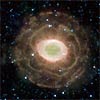
|
 |
Gamma-ray bursts detected by new satellite pinpointed
Cosmic gamma-ray bursts produce more energy in the blink of an eye, than the Sun will release in its entire lifetime. These short-lived explosions appear to be the death throes of massive stars, and, many scientists believe, mark the birth of black holes. Testing these ideas has been difficult, however, because the bursts fade so quickly and rapid action is required.
 FULL STORY FULL STORY
 |  |

|
 |
Ambitious solar sail could launch this spring
��The Planetary Society's oft-delayed Cosmos 1 solar sail is finally on the verge of launching on its test mission to validate the practicality of a revolutionary propulsion method that relies on sunlight instead of chemical rocket fuels.
 FULL STORY FULL STORY
 |  |
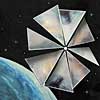
|
 |
Lockheed Martin reducing workforce at the Cape
Lockheed Martin will eliminate approximately 425 jobs at Cape Canaveral over the next several months as it transitions to new launch vehicles. The reduction includes about 100 workers on the Atlas program, which recently completed launches from Complex 36, and 325 jobs for the Titan 4 rocket that sees its final Florida liftoff later this year.
 FULL STORY FULL STORY
 |  |
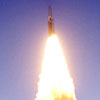
|
 |
First stellar outcast discovered by astronomers
Astronomers have reported the discovery of a star leaving our galaxy, speeding along at over 1.5
million miles per hour. This incredible speed likely resulted from a close encounter with the Milky Way's central black hole, which flung the star outward like a stone from a slingshot. So strong was the event that the speedy star eventually will be lost altogether, traveling alone in the blackness of intergalactic space.
 FULL STORY FULL STORY
 |  |
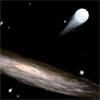
|
 |
NASA data could fill Library of Congress 300 times
The largest scientific data system on the planet, the Earth Observing System Data and Information System (EOSDIS), is providing users around the world with unprecedented access to huge amounts of important information about the Earth's environment.
 FULL STORY FULL STORY
 |  |

|
 |
Redesigned Ariane 5 ECA rocket launches to space
Europe's upgraded Ariane 5 ECA rocket launched from the jungles of South America on Saturday, lifting off at 2103 GMT (4:03 p.m. EST) on a vital mission to test its redesigned main engine and new, unproven cryogenic upper stage. The first flight of the ECA failed two years ago.
 MISSION STATUS CENTER MISSION STATUS CENTER
 |  |
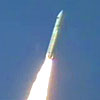
|
 |
Scientists reveal smallest extra-solar planet yet found
Penn State's Alex Wolszczan, the discoverer in 1992 of the first planets ever found outside our
solar system, now has discovered the smallest planet yet detected, in that same far-away planetary system. Immersed in an extended cloud of ionized gas, the new planet orbits a rapidly spinning neutron star called a pulsar.
 FULL STORY FULL STORY
 |  |
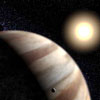
|
 |
3 repair demos, not 4, planned for Discovery
The shuttle Discovery's astronauts will test three, not four, tile and wing leading edge repair techniques during the first post-Columbia shuttle flight in May, NASA officials clarified today.
 FULL STORY FULL STORY
 ORIGINAL STORY ORIGINAL STORY
 |  |
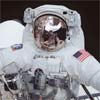
|
 |
Gehman: NASA is meeting intent of Columbia board
The chairman of the Columbia Accident Investigation Board believes NASA has made a credible attempt to meet the spirit and intent of the board's return-to-flight recommendations, even though the agency will not have certified tile or wing leading edge repair techniques in place before Discovery blasts off in May.
 FULL STORY FULL STORY
 |  |
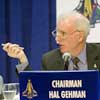
|
 |
Dead-on view of Herschel
Saturn's moon Mimas has many large craters, but its Herschel crater dwarfs all the rest. This large crater 80 miles wide has a prominent central peak, seen here almost exactly on the terminator. This crater is the moon's most prominent feature, and the impact that formed it probably nearly destroyed Mimas.
 FULL STORY FULL STORY
 |  |
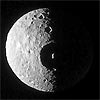
|
 |
Extrasolar planets may have diamond layers
Some extrasolar planets may be made substantially from carbon compounds, including diamond, according to a report presented this week at the conference on extrasolar planets. Earth, Mars and Venus are "silicate planets" consisting mostly of silicon-oxygen compounds. Astrophysicists are proposing that some stars in our galaxy may host "carbon planets" instead.
 FULL STORY FULL STORY
 |  |
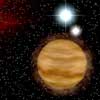
|
 |
Astronaut rosters for upcoming shuttle flights set
NASA has shuffled the astronaut crews to fly fourth and fifth space shuttle missions after the return-to-flight launch this spring, putting a rookie commander in charge of STS-116 and adding new members to STS-117. Both missions, now scheduled for 2006, will continue the orbital construction of the International Space Station.
 FULL STORY FULL STORY
 |  |
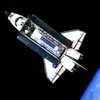
|
 |
First measurement of Titan's winds from Huygens
Scientists have measured the speed of the winds faced by Huygens during its descent through the atmosphere of Titan. The winds are weak near the surface and increase slowly with altitude up to about 60 km, becoming much rougher higher up where significant vertical wind shear may be present.
 FULL STORY FULL STORY
 |  |
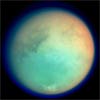
|
 |
Radio telescopes 'save the day' for Titan wind data
In what some scientists termed "a surprising, almost miraculous turnabout," radio telescopes have provided data needed to measure the winds encountered by the Huygens spacecraft as it descended through the atmosphere of Saturn's moon Titan last month -- measurements feared lost because of a communication error between Huygens and its "mother ship" Cassini.
 FULL STORY FULL STORY
 |  |
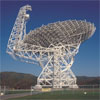
|
 |
First 'modernized' GPS satellite set for launch
An advanced Global Positioning System satellite built to transmit additional navigation signals to benefit military and civilian users around the world has arrived at Cape Canaveral Air Force Station to begin a three-month campaign leading to launch.
 FULL STORY FULL STORY
 |  |
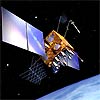
|
 |
Beginnings of 'mini' solar system discovered
Moons circle planets, and planets circle stars. Now, astronomers have learned that planets may also circle celestial bodies almost as small as planets.
 FULL STORY FULL STORY
 |  |
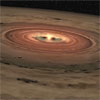
|
 |
Saturn's blue cranium
Saturn's northern hemisphere is presently a serene blue, more befitting of Uranus or Neptune, as seen in this natural color image from Cassini. Shadows cast by the rings surround the pole, looking almost like dark atmospheric bands.
 FULL STORY FULL STORY
 |  |
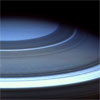
|
 |
Mimas blues
The moon Mimas drifts along in its orbit against the azure backdrop of Saturn's northern latitudes in this true color view. The long, dark lines on the atmosphere are shadows cast by the planet's rings.
 FULL STORY FULL STORY
 |  |
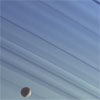
|
 |
NASA budget proposal kills Hubble repair mission
President George W. Bush's proposed 2006 budget would give NASA a modest funding increase, but would cancel a proposed robotic servicing mission to the Hubble Space Telescope as well as a nuclear-powered spacecraft to explore the moons of Jupiter.
 FULL STORY FULL STORY
 O'KEEFE STATEMENT O'KEEFE STATEMENT
 DOWNLOAD THE FULL BUDGET DOCUMENT DOWNLOAD THE FULL BUDGET DOCUMENT
 |  |
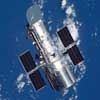
|
 |

Video coverage for subscribers only:
 VIDEO:
NEWS CONFERENCE ON NASA'S 2006 BUDGET REQUEST QT VIDEO:
NEWS CONFERENCE ON NASA'S 2006 BUDGET REQUEST QT
 SUBSCRIBE NOW SUBSCRIBE NOW

|
Using global warming to make Mars suitable for life
Injecting synthetic "super" greenhouse gases into the Martian atmosphere could raise the planet's temperature enough to melt its polar ice caps and create conditions suitable for sustaining biological life. In fact, a team of researchers suggests that introducing global warming on the Red Planet may be the best approach for warming the planet's frozen landscape and turning it into a habitable world in the future.
 FULL STORY FULL STORY
 |  |
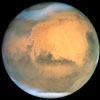
|
 |
Atlas 5 receives contract for NRO satellite launch
International Launch Services has received authorization from the U.S. Air Force to begin operations for launch of a national security payload on an Atlas 5 vehicle in mid-2007 from Cape Canaveral, Fla.
 FULL STORY FULL STORY
 |  |
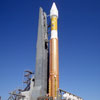
|
 |
Discovery of Pluto reaches 75th anniversary
The planet Pluto turns 75 this month. Clyde Tombaugh discovered the ninth planet in the solar system on the afternoon of February 18, 1930 while he meticulously examined a pair of deep sky photographs at Lowell Observatory.
 FULL STORY FULL STORY
 |  |
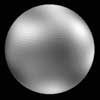
|
 |
Engineers, astronauts debate shuttle repair ideas
With the first post-Columbia shuttle flight just three-and-a-half months away, astronauts and engineers are engaged in a sometimes heated, down-to-the-wire debate over which tile and wing leading edge repair techniques to test in orbit.
 FULL STORY FULL STORY
 RETURN-TO-FLIGHT COVERAGE RETURN-TO-FLIGHT COVERAGE
 |  |
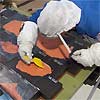
|
 |
Photo gallery: Final launch for Atlas 3 rocket
This collection of pictures from last week's successful Lockheed Martin Atlas 3 rocket launch covers retraction of the mobile service tower, the foggy blastoff from Cape Canaveral and the post-liftoff ceremony inside the Complex 36 blockhouse.
 ENTER GALLERY ENTER GALLERY
 |  |
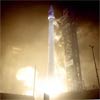
|
 |
New Arecibo sky survey may find 'dark galaxies'
Fitted with its new compound eye on the heavens, the Arecibo Observatory telescope, the world's largest and most sensitive single-dish radio telescope, is beginning a years-long survey of distant galaxies, perhaps discovering elusive "dark galaxies" -- galaxies that are devoid of stars.
 FULL STORY FULL STORY
 |  |
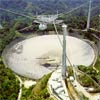
|
 |
Even in heaven, stars can only get so big
New research from the University of Michigan shows that there may be an upper limit to the mass of a star, somewhere around 120 to 200 times bigger than our sun. Knowing that there may be a limit to a star's mass answers a fundamental question, but raises a raft of other issues about what limits their mass, said Sally Oey, assistant professor of astronomy.
 FULL STORY FULL STORY
 |  |
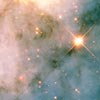
|
 |
Saturn has strange hot spot
Astronomers using the Keck I telescope in Hawaii are learning much more about a strange, thermal "hot spot" on Saturn that is located at the tip of the planet's south pole. In what the team is calling the sharpest thermal views of Saturn ever taken from the ground, the new set of infrared images suggest a warm polar vortex at Saturn's south pole -- the first to ever be discovered in the solar system.
 FULL STORY FULL STORY
 |  |
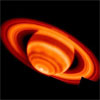
|
 |
Light continues to echo 3 years after stellar outburst
The Hubble Space Telescope's latest image of the star V838 Monocerotis reveals dramatic changes in the illumination of surrounding dusty cloud structures. The effect, called a light echo, has been unveiling never-before-seen dust patterns ever since the star suddenly brightened for several weeks in early 2002.
 FULL STORY FULL STORY
 |  |
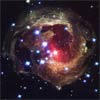
|
 |
Last Atlas 3 rocket launches a pair of spy satellites
While its liftoff was hidden by a dense blanket of fog draped over Cape Canaveral's Complex 36 Thursday morning, the last Lockheed Martin Atlas 3 rocket flew into the history books in fine style as it successfully launched two formation-flying spy satellites probably meant to track enemy ships at sea.
 FULL STORY FULL STORY
 MISSION STATUS CENTER MISSION STATUS CENTER
 |  |
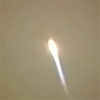
|
 |

Video coverage for subscribers only:
 VIDEO:
FINAL ATLAS 3 ROCKET BLASTS OFF QT VIDEO:
FINAL ATLAS 3 ROCKET BLASTS OFF QT
 VIDEO:
DRAMATIC ONBOARD CAMERA VIEW OF STAGING QT VIDEO:
DRAMATIC ONBOARD CAMERA VIEW OF STAGING QT
 SUBSCRIBE NOW SUBSCRIBE NOW

|
Atlas rocket workers say goodbye to Complex 36
After heart-felt speeches and toasts to say goodbye to the launch site that Atlas-Centaur rockets have called their Cape Canaveral home since the 1960s, the spotlights shining on Complex 36 were turned off in a ceremony following's Thursday's liftoff.
 FULL STORY FULL STORY
 FALCON ROCKETS TO USE COMPLEX 36 FALCON ROCKETS TO USE COMPLEX 36
 |  |
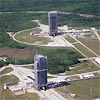
|
 |

Video coverage for subscribers only:
 VIDEO:
FAREWELL CEREMONY TO COMPLEX 36 DIAL-UP | BROADBAND VIDEO:
FAREWELL CEREMONY TO COMPLEX 36 DIAL-UP | BROADBAND
 AUDIO:
FAREWELL CEREMONY TO COMPLEX 36 FOR IPOD AUDIO:
FAREWELL CEREMONY TO COMPLEX 36 FOR IPOD
 SUBSCRIBE NOW SUBSCRIBE NOW

|
Commercial Proton rocket blasts off from Baikonur
A communications satellite designed to serve the Americas, Europe and Africa from its intended perch above the Atlantic Ocean has rocketed into space Wednesday night atop a Russian Proton booster. The 9-hour ascent to geosynchronous transfer orbit began at 9:27 p.m. EST (0227 GMT).
 MISSION STATUS CENTER MISSION STATUS CENTER
 |  |
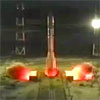
|
 |
Lost and found: Chandra locates missing matter
NASA's Chandra X-ray Observatory has discovered two huge intergalactic clouds of diffuse hot gas. These clouds are the best evidence yet that a vast cosmic web of hot gas contains the long-sought missing matter - about half of the atoms and ions in the Universe.
 FULL STORY FULL STORY
 |  |
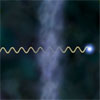
|
 |
Swift sees Pinwheel Galaxy as satellite goes operational
The Swift satellite's Ultraviolet/Optical Telescope has seen first light, capturing an image of the Pinwheel Galaxy, long loved by amateur astronomers as the "perfect" face-on spiral galaxy.
 FULL STORY FULL STORY
 |  |
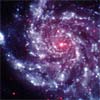
|
 |
Hard X-ray telescope idea up for final NASA review
If all goes well with a technical study approved by NASA for this year, an innovative telescope should be orbiting Earth by the end of the decade and taking the first focused high-energy X-ray pictures of matter falling into black holes and shooting out of exploding stars.
 FULL STORY FULL STORY
 |  |
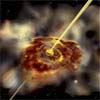
|
 |
Sun-striped Saturn
In a dazzling and dramatic portrait painted by the Sun, the long thin shadows of Saturn's rings sweep across the planet's northern latitudes. Within the shadows, bright bands represent areas where the ring material is less dense, while dark strips and wave patterns reveal areas of denser material.
 FULL STORY FULL STORY
 |  |
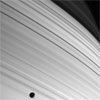
|
 |
Giant Saturn's shadow
Now, in southern summer, Saturn's shadow stretches across the sunlit southern surface of its rings. Saturn's moon Janus orbits just outside of the main rings and appears below them in this scene. Janus is absolutely dwarfed by the bulk of its gigantic parent.
 FULL STORY FULL STORY
 |  |
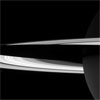
|
 |
Spotlight on Mimas
Mimas is caught in the spotlight beneath Saturn's rings in this amazing view from Cassini. Notable is the brightened outermost edge of the A ring beyond the narrow Keeler gap and the periodic brightening of the thin, knotted F ring.
 FULL STORY FULL STORY
 |  |
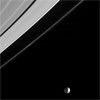
|
 |
Good news from big bad black holes
Astronomers have discovered how ominous black holes can create life in the form of new stars, proving that jet-induced star formation may have played an important role in the formation of galaxies in the early universe.
 FULL STORY FULL STORY
 |  |

|
 |
Experts using computer simulations in Delta 4 probe
While complex computer simulations are being run to understand what interrupted its main engines from finishing their firings, the entire six-hour maiden flight of the Boeing Delta 4-Heavy rocket was examined in deep detail last week as part of a planned post-mission review.
 FULL STORY FULL STORY
 EARLIER DELTA 4-HEAVY COVERAGE EARLIER DELTA 4-HEAVY COVERAGE
 |  |
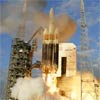
|
 |
NASA selects technology validation experiments
NASA has chosen four teams to develop a suite of advanced technologies slated for space flight validation on the New Millennium Programs Space Technology 8 Mission.
 FULL STORY FULL STORY
 |  |
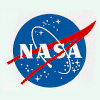
|
 |
NASA research balloon makes record flight
Flying near the edge of space, a NASA scientific balloon broke the flight record for duration and distance. It soared for nearly 42 days, making three orbits around the South Pole.
 FULL STORY FULL STORY
 |  |
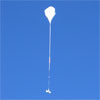
|
 |
Biggest stars produce strongest magnets
Astronomy is a science of extremes - the biggest, the hottest, and the most massive. Astrophysicists announced Friday that they have linked two of astronomy's extremes, showing that some of the biggest stars in the cosmos become the strongest magnets when they die.
 FULL STORY FULL STORY
 |  |
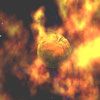
|
 |
Pluto-Charon origin may mirror Earth and Moon
The evolution of Kuiper Belt objects, Pluto and its lone moon Charon may have something in common with Earth and our single Moon: a giant impact in the distant past. Dr. Robin Canup, assistant director of Southwest Research Institute's Department of Space Studies, argues for such an origin for the Pluto-Charon pair in an article for Friday's issue of the journal Science.
 FULL STORY FULL STORY
 |  |
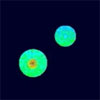
|
 |
First Genesis early-science sample sent to researchers
NASA scientists have sent to academic researchers an unprecedented piece of the sun gathered by the Genesis spacecraft, enabling the start of studies to achieve the mission's initial science objectives.
 FULL STORY FULL STORY
 |  |
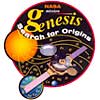
|
 |
19 years after Challenger
On a bitterly cold January morning 19 years ago, space shuttle Challenger and her seven-member crew made a fateful voyage into history. Spaceflight Now marks Friday's anniversary with a comprehensive timeline of the events of that day.
 CHALLENGER TIMELINE CHALLENGER TIMELINE
 |  |
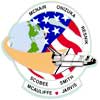
|
 |
Milky Way's super-massive black hole was active
The center of our galaxy has been known for years to host a black hole, a 'super-massive' yet very quiet one. New observations with Integral, the European Space Agency's gamma-ray observatory, have now revealed that 350 years ago the black hole was much more active, releasing a million times more energy than at present. Scientists expect that it will become active again in the future.
 FULL STORY FULL STORY
 |  |

|
 |
Dark matter haloes were first objects in the universe
Ghostly haloes of dark matter as heavy as the earth and as large as our solar system were the first structures to form in the universe, according to new calculations from scientists at the University of Zurich, published in this week's issue of Nature.
 FULL STORY FULL STORY
 |  |
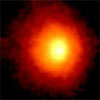
|
 |
OTHER HEADLINES Additional stories today
|
 |
NASA selects new Small Explorer satellite mission -- A satellite that will make the first map of the boundary between the Solar System and interstellar space has been selected as part of NASA's Small Explorer program. The Interstellar Boundary Explorer (IBEX) mission will be launched in 2008.

Joint statement by ISS Heads of Agency -- The heads of space agencies from the United States, Russia, Japan, Europe and Canada met in Montreal Wednesday to review and further advance International Space Station cooperation.
|
 |
Spacewalkers spot residue around vent ports
Spacewalkers Leroy Chiao and Salizhan Sharipov have spotted a residue of some sort on and around a trio of vent ports on the exterior of the Russian command module Zvezda that might shed light on past problems with the space station's air rejuvenation system.
 FULL STORY FULL STORY
 PREVIEW STORY PREVIEW STORY
 |  |
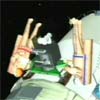
|
 |

Video coverage for subscribers only:
 VIDEO:
HIGHLIGHTS FROM SUCCESSFUL SPACEWALK QT VIDEO:
HIGHLIGHTS FROM SUCCESSFUL SPACEWALK QT
 VIDEO:
SPACEWALK PREVIEW NEWS BRIEFING DIAL-UP | BROADBAND VIDEO:
SPACEWALK PREVIEW NEWS BRIEFING DIAL-UP | BROADBAND
 SUBSCRIBE NOW SUBSCRIBE NOW

|
Hubble's infrared eyes see suspected extrasolar planet
Unique follow up observations carried out with the Hubble Space Telescope are providing important supporting evidence for the existence of a candidate planetary companion to a relatively bright young brown dwarf star located 225 light-years away in the southern constellation Hydra.
 FULL STORY FULL STORY
 |  |
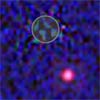
|
 |
Asteroid collisions may explain star's appearance
The recent collision of two huge asteroids or tiny planets may be the cause of the mysterious lopsided appearance of the most famous of the universe's planet-forming stars, a team of astronomers says.
 FULL STORY FULL STORY
 |  |
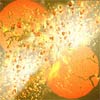
|
 |
Planetoid Sedna may have formed far beyond Pluto
Recently, astronomers reported the surprising discovery of a very large diameter Kuiper Belt planetoid -- named Sedna -- on a distant, 12,500-year-long, eccentric orbit centered approximately 500 astronomical units from the Sun.
 FULL STORY FULL STORY
 |  |
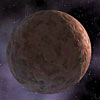
|
 |
Delay for Atlas 3 rocket
Thursday's planned launch of the final Lockheed Martin Atlas 3 rocket from Cape Canaveral has been postponed, according to the Eastern Range. A new launch date is not yet available. The rocket will carry a classified national security payload into space.
 MISSION STATUS CENTER MISSION STATUS CENTER
 |  |
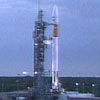
|
 |
Team hopes to pinpoint Delta 4 problem by mid-Feb.
Engineers probing the trouble experienced on the Boeing Delta 4-Heavy rocket's test flight have cleared 40 potential causes of the main engines cutting off prematurely, leaving 9 scenarios on the table, including the leading theory that bubbles formed in the liquid oxygen plumbing.
 FULL STORY FULL STORY
 |  |
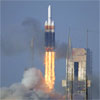
|
 |
New Swift satellite images birth of a black hole
The NASA-led Swift mission has detected and imaged its first gamma-ray burst, likely the birth cry of a brand new black hole. "This is the first time an X-ray telescope has imaged a gamma-ray burst, while it was bursting," the lead scientist says.
 FULL STORY FULL STORY
 |  |
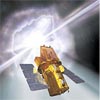
|
 |
Report: Biggest extinction not from asteroid or comet
For the last three years evidence has been building that the impact of a comet or asteroid triggered the biggest mass extinction in Earth history, but new research from a team headed by a University of Washington scientist disputes that notion.
 FULL STORY FULL STORY
 |  |

|
 |
Titan forecast calls for rain, Huygens data shows
Liquid methane apparently falls like rain on Saturn's smog-shrouded moon Titan, washing down icy channels that ultimately spill into broad lakebeds dotted with ice islands and shoals, according to the latest data from Europe's Huygens probe. While the spacecraft did not detect any standing pools of liquefied natural gas in its immediate area, the data indicate rainfall is common on Titan and that liquid methane is present within a few inches of its surface.
 FULL STORY FULL STORY
 |  |
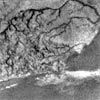
|
 |

Video coverage for subscribers only:
 VIDEO:
FRIDAY'S PHOTO & SCIENCE BRIEFING DIAL-UP | BROADBAND VIDEO:
FRIDAY'S PHOTO & SCIENCE BRIEFING DIAL-UP | BROADBAND
 SUBSCRIBE NOW SUBSCRIBE NOW

|
Swirls in the south
The turbulent boundaries between dark belts and bright zones are seen prominently in this processed image of Saturn's southern atmosphere. Disturbed boundaries between these cloud bands are due to wind shear and density differences between adjacent bands.
 FULL STORY FULL STORY
 |  |
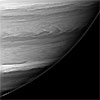
|
 |
Cape launch site could host new commercial rocket fleet
As Lockheed Martin's Atlas program prepares to fly away from Cape Canaveral's Complex 36, an advanced breed of rockets being developed by a self-made millionaire is expected to breathe new life into the historic site.
 FULL STORY FULL STORY
 |  |

|
 |
SpaceX starting small as it dreams of grand plans
Elon Musk conceived SpaceX to offer low-cost access to space, give a boost to what he calls a "stagnate" industry that has failed to evolve since Apollo and build toward the goal of launching human space voyages.
 FULL STORY FULL STORY
 |  |
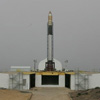
|
 |
Atlas rockets bid farewell to Complex 36 after 40 years
The first probe to orbit another planet. A craft that gave mankind its only up-close look at Mercury. A robotic explorer that will encounter a star four million years from now. Dozens of satellites that expanded communications around the globe and bolstered American national security. These diverse missions are linked in history by launching from the same Cape Canaveral launch pad, which hosts its last Atlas rocket liftoff next Thursday.
 FULL STORY FULL STORY
 LAUNCH EVENTS TIMELINE LAUNCH EVENTS TIMELINE
 GROUND TRACK MAP GROUND TRACK MAP
 |  |
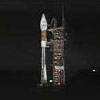
|
 |
Opportunity rover finds an iron meteorite on Mars
NASA's Mars Exploration Rover Opportunity has found an iron meteorite, the first meteorite of any type ever identified on another planet. The pitted, basketball-size object is mostly made of iron and nickel according to readings from spectrometers on the rover.
 FULL STORY FULL STORY
 |  |
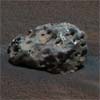
|
 |
Discovery challenges theories on brown dwarfs
Although mass is the most important property of stars, it has proved very hard to measure for the lowest mass objects in the universe. Thanks to a powerful new camera, a very rare, low-mass companion has finally been photographed. The discovery suggests that, due to errors in the models, astronomers have overestimated the number of young "brown dwarfs" and "free floating" extrasolar planets.
 FULL STORY FULL STORY
 |  |
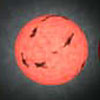
|
 |
Huygens descent probe landed in Titanian mud
Although Huygens landed on Titan's surface last Friday, activity at the European Space Operations Center continues at a furious pace. Scientists are still working to refine the exact location of the probe's landing site.
 FULL STORY FULL STORY
 |  |
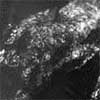
|
 |
Columbia caught possible new luminous flash event
An unprecedented flash observed by the space shuttle Columbia crew in 2003 over the Indian Ocean may be a new type of transient luminous event, like lightning sprites, but one that is not necessarily caused by a thunderstorm. The discharge was observed less than two weeks before the shuttle was lost during its Earth reentry.
 FULL STORY FULL STORY
 |  |

|
 |
Mars instrument to assess astronaut radiation risk
An instrument that will characterize the radiation at the surface of Mars has been selected by NASA for the Mars Science Laboratory (MSL). The mission, part of NASA's Mars Exploration Program, will explore the viability of the surface of the red planet as a potential habitat for past or present life.
 FULL STORY FULL STORY
 |  |
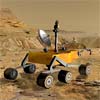
|
 |
|
Tuesday:
January 18, 2005 | |
0120 GMT |
 |
NASA struggles to define shuttle damage threat
Ongoing space shuttle wing leading edge impact tests show tiny cracks or even damaged surface coating, coupled with internal delamination, can lead to catastrophic failure.
 FULL STORY FULL STORY
 |  |
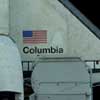
|
 |
Hubble finds infant stars in neighboring galaxy
Hubble astronomers have uncovered, for the first time, a population of infant stars in the Milky Way satellite galaxy, the Small Magellanic Cloud, located 210,000 light-years away.
 FULL STORY FULL STORY
 |  |
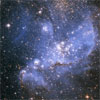
|
 |
Rapidly rotating star dubbed 'King of Spin'
New ultraviolet observations indicate a Milky Way star is spinning nearly 200 times faster than Earth's sun, the probable result of a merger between two sun-like stars whose binary orbit recently collapsed, according to a University of Colorado at Boulder astronomer.
 FULL STORY FULL STORY
 |  |
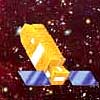
|
 |
|
Monday:
January 17, 2005 | |
0343 GMT |
 |
Spitzer sees aftermath from massive smash-up
Astronomers say a dusty disc swirling around the nearby star Vega is bigger than earlier thought. It was probably caused by collisions of objects, perhaps as big as the planet Pluto. It is believed that embryonic planets smashed together, shattered into pieces and repeatedly crashed into other fragments to create ever-finer debris.
 FULL STORY FULL STORY
 |  |
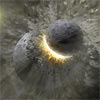
|
 |
Intelsat spacecraft a goner after electrical failure
For the second time in less than two months, Intelsat's global fleet of communications spacecraft has suffered a satellite malfunction. This latest incident occurred Friday evening and knocked out the Lockheed Martin-built Intelsat 804 craft.
 FULL STORY FULL STORY
 |  |
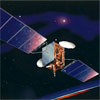
|
 |
Observatory watched Titan when Huygens arrived
The Huygens probe impacted Titan's atmosphere Friday, with an expected landing on Titan's mysterious surface three hours later. This near-infrared image shows Titan at the moment Huygens reached its target as seen from the Keck Observatory on Earth.
 FULL STORY FULL STORY
 |  |
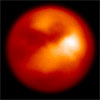
|
 |
|
Sunday:
January 16, 2005 | |
0001 GMT |
 |
Scientists elated with quality of Huygens data
A missing computer command - apparently the result of human error - caused the loss of half the pictures taken by Europe's Huygens probe as it descended to the surface of Saturn's moon Titan. But project officials said Saturday the 350 pictures that made it back, along with high-quality data from
the spacecraft's other instruments and unexpected measurements by Earth-based radio telescopes, should fulfill all of the mission's primary objectives.
 FULL STORY FULL STORY
 PHOTO: MONTAGE OF HUYGENS PICTURES PHOTO: MONTAGE OF HUYGENS PICTURES
 |  |
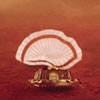
|
 |
Surface of Saturn's moon Titan revealed in color
Tired and weary after a sleepless night spent sorting through their data, scientists on Saturday unveiled more pictures returned from the European Space Agency's Huygens probe that landed on Saturn's moon Titan Friday.
 PHOTO: TITAN IN COLOR PHOTO: TITAN IN COLOR
 PHOTO: SIZES OF SURFACE FEATURES PHOTO: SIZES OF SURFACE FEATURES
 PHOTO: OVERHEAD VIEW OF TERRAIN PHOTO: OVERHEAD VIEW OF TERRAIN
 PHOTO: MOSAIC OF MANY IMAGES PHOTO: MOSAIC OF MANY IMAGES
 MISSION STATUS CENTER MISSION STATUS CENTER
 |  |
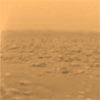
|
 |

Video coverage for subscribers only:
 VIDEO:
THE NEW PICTURES PRESENTED WITH EXPERT NARRATION QT VIDEO:
THE NEW PICTURES PRESENTED WITH EXPERT NARRATION QT
 VIDEO:
LISTEN TO SOUNDS FROM HUYGENS WITH NARRATION QT VIDEO:
LISTEN TO SOUNDS FROM HUYGENS WITH NARRATION QT
 AUDIO:
LISTEN TO SOUNDS FROM HUYGENS WITH NARRATION FOR IPOD AUDIO:
LISTEN TO SOUNDS FROM HUYGENS WITH NARRATION FOR IPOD
 VIDEO:
RESULTS FROM HUYGENS' SURFACE SCIENCE PACKAGE QT VIDEO:
RESULTS FROM HUYGENS' SURFACE SCIENCE PACKAGE QT
 VIDEO:
CHIEF SCIENTIST EXPLAINS COMMUNICATIONS ERROR QT VIDEO:
CHIEF SCIENTIST EXPLAINS COMMUNICATIONS ERROR QT
 VIDEO:
SATURDAY PHOTO & SCIENCE BRIEFING DIAL-UP | BROADBAND VIDEO:
SATURDAY PHOTO & SCIENCE BRIEFING DIAL-UP | BROADBAND
 AUDIO:
SATURDAY PHOTO & SCIENCE BRIEFING FOR IPOD AUDIO:
SATURDAY PHOTO & SCIENCE BRIEFING FOR IPOD
 SUBSCRIBE NOW SUBSCRIBE NOW

|
|
Saturday:
January 15, 2005 | |
0554 GMT |
 |
European probe becomes Titan's first visitor
The European Space Agency's ambitious Huygens probe descended to Saturn's moon Titan Friday, becoming the first spacecraft to touch the mysterious world's surface. Titan is believed to resemble conditions of a young Earth. A mission scientist says the first picture released shows what could be drainage channels flowing to a possible shoreline.
 FULL STORY FULL STORY
 SEE FIRST PICTURES SEE FIRST PICTURES
 ONE DATA CHANNEL LOST ONE DATA CHANNEL LOST
 CASSINI RELAYS THE DATA CASSINI RELAYS THE DATA
 HUYGENS MISSION ENDS HUYGENS MISSION ENDS
 PROBE PHONES HOME PROBE PHONES HOME
 LANDING PREVIEW STORY LANDING PREVIEW STORY
 |  |
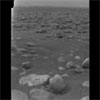
|
 |

Video coverage for subscribers only:
 VIDEO:
THE FIRST PICTURE FROM HUYGENS IS REVEALED QT VIDEO:
THE FIRST PICTURE FROM HUYGENS IS REVEALED QT
 VIDEO:
OFFICIALS OFFER THOUGHTS AFTER SEEING PICTURE QT VIDEO:
OFFICIALS OFFER THOUGHTS AFTER SEEING PICTURE QT
 VIDEO:
HUYGENS POST-LANDING BRIEFING DIAL-UP | BROADBAND VIDEO:
HUYGENS POST-LANDING BRIEFING DIAL-UP | BROADBAND
 AUDIO:
HUYGENS POST-LANDING BRIEFING FOR IPOD AUDIO:
HUYGENS POST-LANDING BRIEFING FOR IPOD
 VIDEO:
STATUS REPORT DURING DESCENT DIAL-UP | BROADBAND VIDEO:
STATUS REPORT DURING DESCENT DIAL-UP | BROADBAND
 AUDIO:
MISSION STATUS REPORT DURING DESCENT FOR IPOD AUDIO:
MISSION STATUS REPORT DURING DESCENT FOR IPOD
 VIDEO:
HUYGENS PRE-ARRIVAL NEWS BRIEFING DIAL-UP | BROADBAND VIDEO:
HUYGENS PRE-ARRIVAL NEWS BRIEFING DIAL-UP | BROADBAND
 AUDIO:
HUYGENS PRE-ARRIVAL NEWS BRIEFING FOR IPOD AUDIO:
HUYGENS PRE-ARRIVAL NEWS BRIEFING FOR IPOD

 VIDEO:
OVERVIEW OF HUYGENS PROBE'S SCIENCE OBJECTIVES QT VIDEO:
OVERVIEW OF HUYGENS PROBE'S SCIENCE OBJECTIVES QT
 VIDEO:
JULY NEWS BRIEFING ON CASSINI'S PICTURES OF TITAN QT VIDEO:
JULY NEWS BRIEFING ON CASSINI'S PICTURES OF TITAN QT
 VIDEO:
PICTURES SHOWING TITAN SURFACE FROM OCT. FLYBY QT VIDEO:
PICTURES SHOWING TITAN SURFACE FROM OCT. FLYBY QT
 VIDEO:
WHAT'S KNOWN ABOUT TITAN BEFORE THE FIRST FLYBY QT VIDEO:
WHAT'S KNOWN ABOUT TITAN BEFORE THE FIRST FLYBY QT
 VIDEO:
NARRATED MOVIE OF CLOUDS MOVING NEAR SOUTH POLE QT VIDEO:
NARRATED MOVIE OF CLOUDS MOVING NEAR SOUTH POLE QT
 VIDEO:
OCT. BRIEFING ON RADAR IMAGES OF TITAN SURFACE QT VIDEO:
OCT. BRIEFING ON RADAR IMAGES OF TITAN SURFACE QT
 SUBSCRIBE NOW SUBSCRIBE NOW

|
Bubbles in Delta 4-Heavy's plumbing possible culprit
Investigators are theorizing that the flow of super-cold liquid oxygen in the three core boosters of Boeing's first Delta 4-Heavy rocket could have been disturbed, creating "bubbles" that tricked internal sensors into thinking the motors were out of fuel and causing them to command a premature engine shutdown, the Air Force said Friday.
 FULL STORY FULL STORY
 EARLIER DELTA 4-HEAVY COVERAGE EARLIER DELTA 4-HEAVY COVERAGE
 |  |
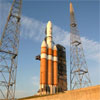
|
 |
|
Friday:
January 14, 2005 | |
0001 GMT |
 |
Deep Impact emerges from protective safe mode
NASA's Deep Impact spacecraft is out of safe mode, healthy and on its way to an encounter with comet Tempel 1 on July 4, the space agency said Thursday.
 FULL STORY FULL STORY
 |  |
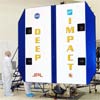
|
 |
NOAA-N satellite arrives at Vandenberg for launch
The latest polar-orbiting operational environmental satellite developed by NASA for the National Oceanic and Atmospheric Administration, called NOAA-N, arrived at California's Vandenberg Air Force Base on Thursday. NOAA-N will undergo final testing and launch processing prior to its scheduled March 19 launch atop a Delta 2 rocket.
 FULL STORY FULL STORY
 |  |
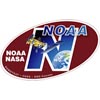
|
 |
|
Thursday:
January 13, 2005 | |
0411 GMT |
 |
Probe launched to smack heart of wandering comet
Look out Comet Tempel 1, here comes Deep Impact! A washing machine-sized projectile tucked inside its mothership spacecraft launched from Earth Wednesday on a 268-million-mile collision course that promises to create spectacular July Fourth fireworks when the 820-pound copper-tipped bullet smashes into the comet's frigid heart.
 FULL STORY FULL STORY
 MISSION STATUS CENTER MISSION STATUS CENTER
 PHOTO GALLERY: SERVICE TOWER ROLLBACK PHOTO GALLERY: SERVICE TOWER ROLLBACK
 PHOTO GALLERY: ROCKET AT SUNRISE PHOTO GALLERY: ROCKET AT SUNRISE
 |  |
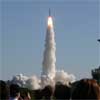
|
 |

Video coverage for subscribers only:
 VIDEO:
DEEP IMPACT BLASTS OFF ATOP DELTA 2 ROCKET QT VIDEO:
DEEP IMPACT BLASTS OFF ATOP DELTA 2 ROCKET QT
 VIDEO:
LONGER-DURATION MOVIE OF TODAY'S LAUNCH QT VIDEO:
LONGER-DURATION MOVIE OF TODAY'S LAUNCH QT
 VIDEO:
LAUNCH AS SEEN FROM THE CAPE PRESS SITE QT VIDEO:
LAUNCH AS SEEN FROM THE CAPE PRESS SITE QT
 VIDEO:
WIDER-ANGLE LAUNCH VIEW FROM PRESS SITE QT VIDEO:
WIDER-ANGLE LAUNCH VIEW FROM PRESS SITE QT
 VIDEO:
COCOA BEACH TRACKING CAMERA VIDEO OF LAUNCH QT VIDEO:
COCOA BEACH TRACKING CAMERA VIDEO OF LAUNCH QT
 VIDEO:
TRACKER POSITIONED NORTH OF THE LAUNCH PAD QT VIDEO:
TRACKER POSITIONED NORTH OF THE LAUNCH PAD QT
 VIDEO:
PLAYALINDA BEACH TRACKING CAMERA VIEW QT VIDEO:
PLAYALINDA BEACH TRACKING CAMERA VIEW QT
 VIDEO:
CLOSE-UP VIEW OF ENGINE IGNITION QT VIDEO:
CLOSE-UP VIEW OF ENGINE IGNITION QT

 VIDEO:
MOBILE SERVICE TOWER ROLLED BACK BEFORE DAWN QT VIDEO:
MOBILE SERVICE TOWER ROLLED BACK BEFORE DAWN QT
 VIDEO:
NARRATION OF DEEP IMPACT'S PRE-LAUNCH CAMPAIGN QT VIDEO:
NARRATION OF DEEP IMPACT'S PRE-LAUNCH CAMPAIGN QT
 VIDEO:
ON-PAD ASSEMBLY OF ROCKET SHOWN WITH NARRATION QT VIDEO:
ON-PAD ASSEMBLY OF ROCKET SHOWN WITH NARRATION QT
 VIDEO:
TUESDAY'S PRE-LAUNCH NEWS UPDATE DIAL-UP | BROADBAND VIDEO:
TUESDAY'S PRE-LAUNCH NEWS UPDATE DIAL-UP | BROADBAND
 VIDEO:
SCIENCE BRIEFING ON EVE OF LAUNCH DIAL-UP | BROADBAND VIDEO:
SCIENCE BRIEFING ON EVE OF LAUNCH DIAL-UP | BROADBAND
 VIDEO:
OVERVIEW OF NASA'S DEEP IMPACT MISSION QT VIDEO:
OVERVIEW OF NASA'S DEEP IMPACT MISSION QT
 VIDEO:
LEAD RESEARCHER PREVIEWS DEEP IMPACT SCIENCE QT VIDEO:
LEAD RESEARCHER PREVIEWS DEEP IMPACT SCIENCE QT
 VIDEO:
WATCH DEEP IMPACT PRE-FLIGHT NEWS BRIEFING QT VIDEO:
WATCH DEEP IMPACT PRE-FLIGHT NEWS BRIEFING QT
 SUBSCRIBE NOW SUBSCRIBE NOW

|
New clues found in mystery of giant galactic blobs
Astronomers have numerous technical terms and numbering systems for describing the universe, but one type of mysterious object has yet to be classified. For now, these oddities are named for their strange appearance. They are called blobs.
 FULL STORY FULL STORY
 |  |
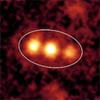
|
 |
Stellar 'incubators' found with massive star embryos
NASA's Spitzer Space Telescope has uncovered a hatchery for massive stars. A new striking image from the infrared telescope shows a vibrant cloud called the Trifid Nebula dotted with glowing stellar "incubators." Deep inside these incubators are rapidly growing embryonic stars, whose warmth Spitzer was able to see for the first time with its powerful heat-seeking eyes.
 FULL STORY FULL STORY
 |  |
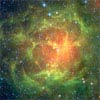
|
 |
|
Wednesday:
January 12, 2005 | |
0050 GMT |
 |
Chandra: Swarm of black holes near galactic center
A swarm of 10,000 or more black holes may be orbiting the Milky Way's supermassive black hole, according to new results from NASA's Chandra X-ray Observatory. This would represent the highest concentration of black holes anywhere in the Galaxy.
 FULL STORY FULL STORY
 |  |
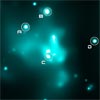
|
 |
Saharan dust affects Florida thunderstorms
Scientists using NASA satellite data have discovered tiny particles of dust blowing across the Atlantic Ocean from the Sahara Desert can affect Florida thunderstorms.
 FULL STORY FULL STORY
 |  |
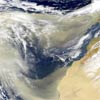
|
 |
|
Tuesday:
January 11, 2005 | |
0338 GMT |
 |
Satellite sees matter speed-racing around a black hole
Using a 'radar-gun' technique, scientists have clocked three separate clumps of hot iron gas whipping around a black hole at 30,000 kilometres per second, about a tenth of the speed of light. The observation, made with ESA's XMM-Newton observatory, marks the first time scientists could trace individual blobs of shredded matter on a complete journey around a black hole.
 FULL STORY FULL STORY
 |  |

|
 |
Beyond Einstein: Spacetime wave orbits black hole
Astronomers have seen evidence of hot iron gas riding a ripple in spacetime around a black hole. This spacetime wave, if confirmed, would represent a new phenomenon that goes beyond Einstein's general relativity. These observations confirm one important theory about how a black hole's extreme gravity can stretch light.
 FULL STORY FULL STORY
 |  |

|
 |
NASA details earthquake affects on the Earth
NASA scientists using data from the Indonesian earthquake calculated it affected Earth's rotation, decreased the length of day, slightly changed the planet's shape, and shifted the North Pole by centimeters. The earthquake that created the huge tsunami also changed the Earth's rotation.
 FULL STORY FULL STORY
 |  |

|
 |
See-through galaxy
The center of our galaxy is hidden behind a "brick wall" of obscuring dust so thick that not even the Hubble Space Telescope can penetrate it. Astronomers at the Harvard-Smithsonian Center for Astrophysics have lifted that veil to reveal a beautiful vista swarming with stars.
 FULL STORY FULL STORY
 |  |
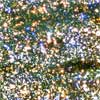
|
 |
|
Monday:
January 10, 2005 | |
0027 GMT |
 |
Encountering Iapetus
On New Year's Eve 2004, Cassini flew past Saturn's intriguing moon Iapetus, capturing images that were put together to form this global view. The scene is dominated by a dark, heavily-cratered region, called Cassini Regio, that covers nearly an entire hemisphere of Iapetus.
 FULL STORY FULL STORY
 |  |
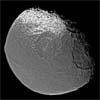
|
 |
Iapetus: View from the top
This oblique view of Saturn's moon Iapetus from high latitude shows how the dark, heavily cratered terrain of Cassini Regio transitions to a bright, icy terrain.
 FULL STORY FULL STORY
 |  |
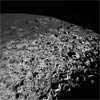
|
 |
Giant landslide on Iapetus
A spectacular landslide within the low-brightness region of Iapetus's surface known as Cassini Regio is visible in this image from Cassini. The landslide material appears to have collapsed from a scarp 9 miles high that forms the rim of an ancient 375-mile impact basin.
 FULL STORY FULL STORY
 |  |
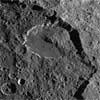
|
 |
|
Sunday:
January 9, 2005 | |
0441 GMT |
 |
Maps reveal dark matter clumps in galaxies
Hubble Space Telescope data, analyzed by a Yale astronomer using gravitational lensing techniques, has generated a spatial map demonstrating the clumped substructure of dark matter inside clusters of galaxies.
 FULL STORY FULL STORY
 |  |
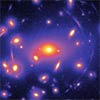
|
 |
Site picked in Hawaii for new solar observatory
Plans for the world's largest solar optical telescope moved forward Friday when recommendations were endorsed to build the 4-meter Advanced Technology Solar Telescope at Haleakala, Maui, Hawaii. The observatory will become the world's most powerful solar optical telescope when it starts operating around 2012.
 FULL STORY FULL STORY
 |  |
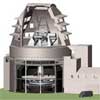
|
 |
|
Saturday:
January 8, 2005 | |
0000 GMT |
 |
Delta 4-Heavy's engines snuffed out by sensor glitch
Errant readings from sensors inside the inaugural Boeing Delta 4-Heavy rocket triggered the premature shutdown of its three main engines during ascent last month, causing a massive underspeed that the vehicle's upper stage could not overcome and resulting in a final orbit lower than planned, the U.S. Air Force said Friday. A team investigating results of the test launch are confident the problem can be resolved.
 FULL STORY FULL STORY
 EARLIER D4-HEAVY COVERAGE EARLIER D4-HEAVY COVERAGE
 |  |
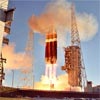
|
 |
|
Friday:
January 7, 2005 | |
0441 GMT |
 |
Deep Impact: NASA's crash course in comet science
As ancient wanderers of the solar system laden with primordial material frozen in time, comets offer humanity clues to some of the most fundamental questions about conditions when the planets were forming more than four billion years ago. NASA will launch a space mission Wednesday to blast a hole in the side of a comet and learn more about the make up of these icy bodies.
 FULL STORY FULL STORY
 |  |
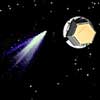
|
 |
Weather outlook is good for Deep Impact launch
The Air Force weather team is predicting favorable conditions for Wednesday's blastoff of the Boeing Delta 2 rocket carrying NASA's Deep Impact comet probe.
 MISSION STATUS CENTER MISSION STATUS CENTER
 |  |
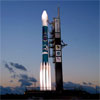
|
 |
|
Thursday:
January 6, 2005 | |
0231 GMT |
 |
Shuttle tank arrives at Kennedy Space Center
The covered barge ferrying the re-designed space shuttle external fuel tank from New Orleans to the Kennedy Space Center arrived at the spaceport Wednesday, pulling into unloading port just before 2 p.m. EST. The tank will be used by Discovery for the shuttle return-to-flight launch in May. Workers plan to offload the tank Thursday and transport it into the Vehicle Assembly Building for eventual mating with the solid rocket boosters.
 FULL STORY FULL STORY
 EARLIER PREVIEW STORY EARLIER PREVIEW STORY
 |  |
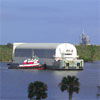
|
 |
Most powerful eruption in the universe discovered
Astronomers have found the most powerful eruption in the universe using NASA's Chandra X-ray Observatory. A super massive black hole generated this eruption by growing at a remarkable rate. This discovery shows the enormous appetite of large black holes, and the profound impact they have on their surroundings.
 FULL STORY FULL STORY
 |  |
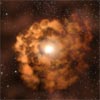
|
 |
New Swift satellite captures gamma-ray-burst afterglow
The Swift X-ray Telescope has seen first light, capturing a dazzling image of Cassiopeia A, a well-known supernova remnant in the Milky Way galaxy, and also has discovered its first gamma-ray-burst afterglow.
 FULL STORY FULL STORY
 SWIFT LAUNCH COVERAGE SWIFT LAUNCH COVERAGE
 |  |

|
 |
|
Wednesday:
January 5, 2005 | |
0441 GMT |
 |
Station crew troubleshoots oxygen generator problem
The Elektron oxygen generator aboard the international space station shut down New Year's Day and after three unsuccessful attempts to flush air bubbles from the device, the station astronauts were forced to tap into oxygen reserves aboard a Russian supply ship Tuesday, NASA officials said.
 FULL STORY FULL STORY
 |  |
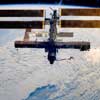
|
 |
Arianespace announces five new launch contracts
Contracts to launch two British military communications satellites, a pair of French Earth observation satellites and a space observatory using European Ariane 5 and Russian Soyuz rockets were announced by Arianespace on Tuesday.
 FULL STORY FULL STORY
 |  |
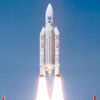
|
 |
Fresh crater on Rhea?
Rhea has been heavily bombarded by impacts during its history. In this Cassini image the moon around Saturn displays what may be a relatively fresh, bright, rayed crater near Rhea's eastern limb. Rhea is 949 miles across.
 FULL STORY FULL STORY
 |  |
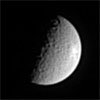
|
 |
|
Tuesday:
January 4, 2005 | |
0531 GMT |
 |
Mars rovers still rolling after a year of exploring
The remarkably inexhaustible Mars rovers, built to explore opposite sides of the Red Planet for three months in early 2004 and uncover proof of past water on Earth's neighbor, are still trucking along to the amazement and delight of scientists one year after the adventure began.
 FULL STORY FULL STORY
 MARS ROVER ARCHIVE MARS ROVER ARCHIVE
 |  |
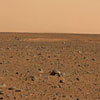
|
 |

Video coverage for subscribers only:
 VIDEO:
MONDAY'S MARS ROVER NEWS CONFERENCE QT VIDEO:
MONDAY'S MARS ROVER NEWS CONFERENCE QT
 VIDEO:
OFFICIALS COMMEMORATE ANNIVERSARY WITH CAKE QT VIDEO:
OFFICIALS COMMEMORATE ANNIVERSARY WITH CAKE QT
 VIDEO:
SPEECH BY NASA ADMINISTRATOR SEAN O'KEEFE QT VIDEO:
SPEECH BY NASA ADMINISTRATOR SEAN O'KEEFE QT
 VIDEO:
'TWELVE WHEELS ON MARS' - THE ROVER STORY QT VIDEO:
'TWELVE WHEELS ON MARS' - THE ROVER STORY QT
 SUBSCRIBE NOW SUBSCRIBE NOW

|
NASA marks rover birthday
NASA lit a birthday candle Monday for its twin Mars Exploration Rovers, Spirit and Opportunity. The Spirit rover begins its second year on Mars investigating puzzling rocks unlike any found earlier.
 NASA STATEMENT NASA STATEMENT
 |  |
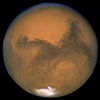
|
 |

Video coverage for subscribers only:
 VIDEO: BEHIND THE SCENES AT MOMENT OF TOUCHDOWN QT VIDEO: BEHIND THE SCENES AT MOMENT OF TOUCHDOWN QT
 VIDEO: CHEERS AND SCREAMS WHEN SPIRIT CONFIRMED ALIVE QT VIDEO: CHEERS AND SCREAMS WHEN SPIRIT CONFIRMED ALIVE QT
 VIDEO: THE LIVE SPIRIT ROVER LANDING COVERAGE QT VIDEO: THE LIVE SPIRIT ROVER LANDING COVERAGE QT
 VIDEO: THE SUCCESSFUL LANDING DESCRIBED AT NEWS BRIEFING QT VIDEO: THE SUCCESSFUL LANDING DESCRIBED AT NEWS BRIEFING QT
 VIDEO: FIRST IMAGES ARE DISCUSSED AT OVERNIGHT CONFERENCE QT VIDEO: FIRST IMAGES ARE DISCUSSED AT OVERNIGHT CONFERENCE QT
 VIDEO: ENTRY, DESCENT & LANDING SEQUENCE EXPLAINED QT VIDEO: ENTRY, DESCENT & LANDING SEQUENCE EXPLAINED QT
 VIDEO: EXPLANATION OF ROVER'S POST-LANDING EVENTS QT VIDEO: EXPLANATION OF ROVER'S POST-LANDING EVENTS QT
 VIDEO: TAKE SIMULATED FLIGHT OVER THE GUSEV CRATER! QT VIDEO: TAKE SIMULATED FLIGHT OVER THE GUSEV CRATER! QT
 MORE: SPIRIT AND OPPORTUNITY LAUNCH REPORT MORE: SPIRIT AND OPPORTUNITY LAUNCH REPORT
 SUBSCRIBE NOW SUBSCRIBE NOW

|
|
Monday:
January 3, 2005 | |
0006 GMT |
 |
2004: NASA's year in review
NASA started the year on an upbeat and positive note, when President George W. Bush announced the Vision for Space Exploration on January 14. His announcement at NASA Headquarters in Washington of a robust space exploration program to advance U.S. scientific, security and economic interests became the keystone for NASA's transformation.
 FULL STORY FULL STORY
 |  |

|
 |
Giant star's corona brightens with age
Beta Ceti is a bright, giant star with a hot corona that radiates about 2,000 times more X-ray power than the Sun. Scientists suspect that this X-ray activity is somehow related to its advanced stage of evolution called core helium burning. During this stage, the core of the star is very hot and converting helium to carbon via nuclear fusion reactions.
 FULL STORY FULL STORY
 |  |
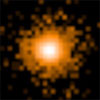
|
 |
|
Sunday:
January 2, 2005 | |
0350 GMT |
 |
Galactic fireworks image to kick off the New Year
Like the annual New Year's fireworks display, astronomers at Gemini Observatory are ushering in 2005 with a striking image that dazzles the eye with stellar pyrotechnics. In the image, the face-on spiral galaxy NGC 6946 is ablaze with colorful galactic fireworks fueled by the births and deaths of multitudes of brilliant, massive stars.
 FULL STORY FULL STORY
 |  |

|
 |
|
Saturday:
January 1, 2005 | |
0001 GMT |
 |
Space shuttle external tank begins journey to launch
The huge, orange external tank that will help launch space shuttle Discovery on its next mission isn't glitzy like the crystal New Year's ball in Times Square. But its journey from NASA's Michoud Assembly Facility marks something special for 2005: the Year of Return to Flight.
 FULL STORY FULL STORY
 |  |
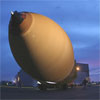
|
 |
|
Friday:
December 31, 2004 | |
0210 GMT |
 |
Cassini ends 2004 with flyby of icy moon Iapetus
NASA's Cassini spacecraft is set to cap off 2004 with an encounter of Saturn's ying-yang moon Iapetus on New Year's Eve. Iapetus is a world of sharp contrasts. The leading hemisphere is as dark as a freshly-tarred street, and the white, trailing hemisphere resembles freshly-fallen snow.
 FULL STORY FULL STORY
 EARLIER IAPETUS IMAGERY EARLIER IAPETUS IMAGERY
 |  |
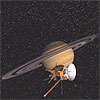
|
 |
Tethys' great rift
This dazzling new view of Saturn's moon Tethys from the Cassini spacecraft shows the tremendous rift called Ithaca Chasma, which is 60 miles wide in places, and runs nearly three-fourths of the way around the icy moon.
 FULL STORY FULL STORY
 |  |
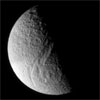
|
 |
Cassini shows moon's influence at ringed Saturn
The moon Mimas orbits beyond the outer fringes of Saturn's main rings, perturbing the orbits of ring particles and creating gaps like the Huygens Gap as seen in this new Cassini picture.
 FULL STORY FULL STORY
 CASSINI NEWS ARCHIVE CASSINI NEWS ARCHIVE
 |  |
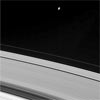
|
 |
|
Thursday:
December 30, 2004 | |
0336 GMT |
 |
Polluted clouds hold less moisture, NASA says
A NASA study found some clouds that form on tiny haze particles are not cooling the Earth as much as previously thought. These findings have implications for the ability to predict changes in climate.
 FULL STORY FULL STORY
 |  |

|
 |
Stars of wonder, stars of infrared and X-ray light
This montage shows three clusters of bright, young stars in X-ray (blue) and infrared (green) light that lie in the direction of the center of the Galaxy. Like many stars in the disk of the Galaxy, they are difficult, if not impossible, to see with an optical telescope because of interstellar dust that blocks the visible light.
 FULL STORY FULL STORY
 |  |
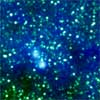
|
 |
|
Wednesday:
December 29, 2004 | |
0250 GMT |
 |
Mars rover Opportunity visits heat shield impact site
NASA's Mars Exploration Rover Opportunity has returned this view of its discard heat shield, which crashed to the planet's surface during the craft's descent and landing last January.
 FULL STORY FULL STORY
 |  |
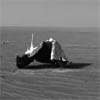
|
 |
Cassini diverts from collision course with moon
NASA's Cassini spacecraft successfully performed a getaway maneuver to keep it from following the Huygens probe into the atmosphere of Saturn's moon Titan. The probe has no navigating capability, so the Cassini orbiter had been placed on a deliberate collision course with Titan to ensure the accurate delivery of the probe to the moon.
 FULL STORY FULL STORY
 |  |
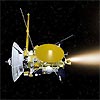
|
 |
Huygens probe shines for Cassini's cameras
The European Space Agency's Huygens probe appears shining as it coasts away from Cassini in this image taken two days after the probe successfully detached from the Cassini spacecraft. It is a follow-up image to one taken 12 hours after the deploy.
 FULL STORY FULL STORY
 |  |

|
 |
|
Tuesday:
December 28, 2004 | |
0458 GMT |
 |
Aging universe may still be spawning massive galaxies
NASA's Galaxy Evolution Explorer has spotted what appear to be massive "baby" galaxies in our corner of the universe. Previously, astronomers thought the universe's birth rate had dramatically declined and only small galaxies were forming.
 FULL STORY FULL STORY
 |  |
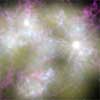
|
 |
|
Monday:
December 27, 2004 | |
0001 GMT |
 |
Cassini takes picture of departing Huygens probe
The Cassini spacecraft snapped this image of the European Space Agency's Huygens probe about 12 hours after its release from the orbiter. The probe successfully detached from Cassini on Friday night and is on course for its January 14 encounter with Titan.
 FULL STORY FULL STORY
 |  |
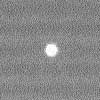
|
 |
|
Sunday:
December 26, 2004 | |
0302 GMT |
 |
Christmas delivery for international space station
A Russian resupply ship successfully docked with the international space station Christmas day, ending an unexpected food shortage that had raised the prospect of an evacuation.
 FULL STORY FULL STORY
 STATION VISIBLE OVER U.S. STATION VISIBLE OVER U.S.
 |  |
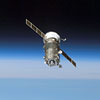
|
 |

Additional coverage for subscribers:
 VIDEO:
CAMERA ON SHIP SHOWS FINAL APPROACH AND DOCKING QT VIDEO:
CAMERA ON SHIP SHOWS FINAL APPROACH AND DOCKING QT
 SUBSCRIBE NOW SUBSCRIBE NOW

|
Radio telescopes will add to Huygens discoveries
When the Huygens spacecraft makes its plunge into the atmosphere of Saturn's moon Titan on January 14, radio telescopes of the National Science Foundation's National Radio Astronomy Observatory will help international teams of scientists extract the maximum possible amount of irreplaceable information from an experiment unique in human history.
 FULL STORY FULL STORY
 |  |

|
 |
|
Saturday:
December 25, 2004 | |
0615 GMT |
 |
Cassini orbiter deploys Titan descent probe
In a long-awaited milestone, a European-built probe carrying cameras and a suite of scientific instruments was released from NASA's Cassini Saturn orbiter Christmas Eve, setting up a dramatic Jan. 14 plunge into the atmosphere of the ringed planet's mysterious moon Titan.
 FULL STORY - updated @ 12:50 a.m. EST FULL STORY - updated @ 12:50 a.m. EST
 DETAILED TIMELINE DETAILED TIMELINE
 |  |
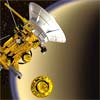
|
 |
Desperately needed station supply ship launched
An unmanned Russian supply ship blasted off from Kazakhstan Thursday evening on a critical flight to deliver two-and-a-half tons of equipment, spare parts, water and the fresh food the lab's two-man crew needs to stay in orbit beyond the first week in January.
 FULL STORY FULL STORY
 |  |
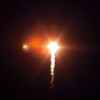
|
 |
|
Friday:
December 24, 2004 | |
0001 GMT |
 |
Desperately needed station supply ship to launch
An unmanned Russian supply ship is poised for blastoff today on a critical flight to deliver two-and-a-half tons of equipment, spare parts, water and the fresh food the lab's two-man crew needs to stay in orbit beyond the first week in January.
 FULL STORY FULL STORY
 |  |
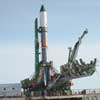
|
 |
|
Thursday:
December 23, 2004 | |
0412 GMT |
 |
Air Force: Plenty of good came from Delta 4 test
While stressing the positives of Tuesday's demonstration flight of the Boeing Delta 4-Heavy rocket and the mountain of data generated about the big booster's actions, Air Force officials on Wednesday acknowledged an "anomaly" occurred during the first stage and two university-built nanosats were lost after not reaching orbit.
 FULL STORY FULL STORY
 |  |
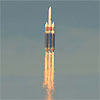
|
 |
Science instruments picked for NASA's new lunar probe
NASA has selected six proposals to provide instrumentation and associated exploration/science measurement investigations for the Lunar Reconnaissance Orbiter (LRO), the first spacecraft to be built as part of the Vision for Space Exploration.
 FULL STORY FULL STORY
 |  |
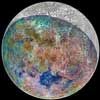
|
 |
New spy satellite launch added to Atlas 5 lineup
Lockheed Martin's Atlas 5 rocket has won another flight assignment under the U.S. Air Force's Evolved Expendable Launch Vehicle program, bringing the next-generation booster's military backlog to 19 missions.
 FULL STORY FULL STORY
 |  |
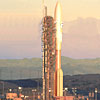
|
 |
|
Wednesday:
December 22, 2004 | |
1730 GMT |
 |
Delta 4-Heavy rocket hits snag on test flight
The test launch of Boeing's Delta 4-Heavy rocket began with a breath-taking blastoff from Cape Canaveral Tuesday afternoon but lower-than-expected performance during the initial minutes of flight ultimately caused the mission to fall short of its intended orbit.
 FULL STORY FULL STORY
 PHOTO GALLERY: FIRST LAUNCH VIEWS PHOTO GALLERY: FIRST LAUNCH VIEWS
 PHOTO GALLERY: ROCKET FLIES DOWNRANGE PHOTO GALLERY: ROCKET FLIES DOWNRANGE
 PHOTO GALLERY: CAMERAS AT LAUNCH PAD PHOTO GALLERY: CAMERAS AT LAUNCH PAD
 PHOTO GALLERY: MORE STUNNING PICTURES PHOTO GALLERY: MORE STUNNING PICTURES
 |  |
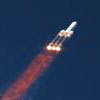
|
 |

Additional coverage for subscribers:
 VIDEO:
FROM LIFTOFF TO BOOSTER SEPARATION QT VIDEO:
FROM LIFTOFF TO BOOSTER SEPARATION QT
 VIDEO:
THE DELTA 4-HEAVY LAUNCH (SHORT VERSION) QT VIDEO:
THE DELTA 4-HEAVY LAUNCH (SHORT VERSION) QT
 VIDEO:
ONBOARD CAMERA RECORDS LAUNCH QT VIDEO:
ONBOARD CAMERA RECORDS LAUNCH QT
 VIDEO:
ONBOARD CAMERA SEES BOOSTER SEPARATION QT VIDEO:
ONBOARD CAMERA SEES BOOSTER SEPARATION QT
 VIDEO:
ONBOARD CAMERA CAPTURES FAIRING JETTISON QT VIDEO:
ONBOARD CAMERA CAPTURES FAIRING JETTISON QT
 SUBSCRIBE NOW SUBSCRIBE NOW

|
Tracking shows rocket's final orbit well off the mark
The DemoSat satellite simulator launched aboard the Delta 4-Heavy rocket Tuesday was delivered into an orbit 10,000 miles short of the intended altitude, according to tracking data. The payload failed to reach the proper orbit because the upper stage ran out of fuel after compensating for low performance from the first stage.
 MISSION STATUS CENTER MISSION STATUS CENTER
 |  |
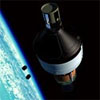
|
 |
|
Tuesday:
December 21, 2004 | |
0001 GMT |
 |
Delta 4-Heavy rocket poised for debut Tuesday
America's new heavy-lifting rocket takes its much-anticipated test flight Tuesday. Boeing's inaugural Delta 4-Heavy rocket is scheduled to make its thunderous departure from Cape Canaveral's pad 37B at 2:36 p.m. EST (1936 GMT) while riding 1.9-million pounds of fiery thrust generated by its three hydrogen-fueled engines. Follow the countdown in our live status center:
 MISSION STATUS CENTER - live updates! MISSION STATUS CENTER - live updates!
 |  |
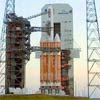
|
 |

Additional coverage for subscribers:
 AUDIO:
LISTEN TO THE 68-MINUTE PRE-LAUNCH NEWS CONFERENCE QT AUDIO:
LISTEN TO THE 68-MINUTE PRE-LAUNCH NEWS CONFERENCE QT
 VIDEO:
ANIMATION PROVIDES PREVIEW OF A DELTA 4-HEAVY LAUNCH QT VIDEO:
ANIMATION PROVIDES PREVIEW OF A DELTA 4-HEAVY LAUNCH QT
 VIDEO:
RE-LIVE THE INAUGURAL DELTA 4 LAUNCH FROM 2002 QT VIDEO:
RE-LIVE THE INAUGURAL DELTA 4 LAUNCH FROM 2002 QT
 VIDEO:
ON-PAD FLIGHT READINESS ENGINE FIRING TEST QT VIDEO:
ON-PAD FLIGHT READINESS ENGINE FIRING TEST QT
 VIDEO:
TAKE TOUR OF LAUNCH PAD 37B QT VIDEO:
TAKE TOUR OF LAUNCH PAD 37B QT
 SUBSCRIBE NOW SUBSCRIBE NOW

|
|
Monday:
December 20, 2004 | |
0436 GMT |
 |
Returning the space shuttle to flight
NASA is gearing up to resume shuttle flights this spring with a three-spacewalk mission to repair the international space station's stabilization system, to deliver critical supplies and equipment and to prove the design defects that contributed to the Columbia disaster have been corrected.
This 10-part, 11,600-word report is focused on details about Discovery's mission and safety upgrades to improve ascent damage detection and potential repair options.
 FULL REPORT FULL REPORT
 |  |
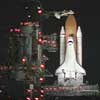
|
 |
Saturn lightning, rotation discoveries made
As NASA's Cassini spacecraft approached Saturn last July, it found evidence that lightning on the planet is roughly one million times stronger than lightning on Earth.
 FULL STORY FULL STORY
 |  |
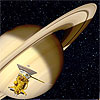
|
 |
|
Sunday:
December 19, 2004 | |
0241 GMT |
 |
New clouds add to mystery of Saturn's moon Titan
Using adaptive optics on the Gemini North and Keck II telescopes on Mauna Kea, Hawai'i, a U.S. team has discovered a new phenomenon in the atmosphere of Saturn's largest moon Titan. Unlike previous observations showing storms at the south pole, these new images reveal atmospheric disturbances at Titan's temperate mid latitudes - about halfway between the equator and the poles.
 FULL STORY FULL STORY
 |  |
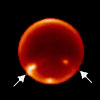
|
 |
Saturn's outer rings may be eroding, Cassini data shows
A massive eruption of atomic oxygen from Saturn's outer rings, seen by Cassini's ultraviolet camera as the spacecraft neared its destination, may be an indication that the planet's wispy E ring is eroding so fast that it could disappear within 100 million years if not replenished.
 FULL STORY FULL STORY
 |  |
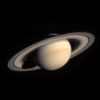
|
 |
|
Saturday:
December 18, 2004 | |
1740 GMT |
 |
Hubble puts a new twist on an old nebula
Looks can be deceiving, especially when it comes to celestial objects like galaxies and nebulas. These objects are so far away that astronomers cannot see their three-dimensional structure. The colorful Helix Nebula is one good example.
 FULL STORY FULL STORY
 |  |
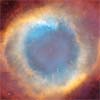
|
 |
Ariane 5 launches French spy satellite, microsats
A large French reconnaissance satellite and six small secondary payloads successfully rode a European Ariane 5 rocket into polar orbit Saturday. The rare daytime liftoff from the Guiana Space Center in South America occurred as scheduled at 1626 GMT (11:26 a.m. EST).
 MISSION STATUS CENTER MISSION STATUS CENTER
 |  |
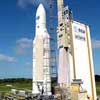
|
 |
|
Friday:
December 17, 2004 | |
2140 GMT |
 |
Atlas 5 rocket completes another successful launch
Call it the ultimate whirlwind experience in the rocket business. In the span of 12 hours, Lockheed Martin's Atlas 5 rocket went to the launch pad, took on its fuel, persevered through a couple of technical bugs, roared off the planet on 31 million horsepower and was rewarded with another success as it deployed a commercial satellite cargo into orbit.
 FULL STORY FULL STORY
 MISSION STATUS CENTER MISSION STATUS CENTER
ATLAS 5 PHOTO GALLERIES
 AV-005: THURSDAY EVENING'S ROLLOUT AV-005: THURSDAY EVENING'S ROLLOUT
 AV-001: INAUGURAL ROCKET ROLLS TO PAD AV-001: INAUGURAL ROCKET ROLLS TO PAD
 AV-001: DEBUT LAUNCH IN AUG. 2002 AV-001: DEBUT LAUNCH IN AUG. 2002
 AV-002: ROLLOUT OF SECOND ROCKET AV-002: ROLLOUT OF SECOND ROCKET
 AV-002: LAUNCH OF GREEK SPACECRAFT AV-002: LAUNCH OF GREEK SPACECRAFT
 AV-003: THIRD ROLLOUT UNVEILS 500-SERIES AV-003: THIRD ROLLOUT UNVEILS 500-SERIES
 AV-003: RAINBOW 1 TV SATELLITE LAUNCHED AV-003: RAINBOW 1 TV SATELLITE LAUNCHED
 |  |
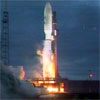
|
 |

Additional coverage for subscribers:
 VIDEO:
6-MINUTE CLIP OF THE ATLAS 5 LAUNCH WITH AMC 16 QT VIDEO:
6-MINUTE CLIP OF THE ATLAS 5 LAUNCH WITH AMC 16 QT
 VIDEO:
LAUNCH AS SEEN FROM THE COMPLEX 39 PRESS SITE QT VIDEO:
LAUNCH AS SEEN FROM THE COMPLEX 39 PRESS SITE QT
 VIDEO:
AMC 16 SUCCESSFULLY DEPLOYED FROM THE ROCKET QT VIDEO:
AMC 16 SUCCESSFULLY DEPLOYED FROM THE ROCKET QT
 VIDEO:
ATLAS 5 ROCKET IS ROLLED TO THE LAUNCH PAD QT VIDEO:
ATLAS 5 ROCKET IS ROLLED TO THE LAUNCH PAD QT
 VIDEO:
THURSDAY'S PRE-LAUNCH NEWS CONFERENCE QT VIDEO:
THURSDAY'S PRE-LAUNCH NEWS CONFERENCE QT
 VIDEO:
NARRATED ANIMATION PREVIEW OF THIS LAUNCH QT VIDEO:
NARRATED ANIMATION PREVIEW OF THIS LAUNCH QT
 VIDEO:
OVERVIEW OF THE AMERICOM 16 SPACECRAFT QT VIDEO:
OVERVIEW OF THE AMERICOM 16 SPACECRAFT QT

 VIDEO:
SIX-MINUTE MOVIE OF INAUGURAL ATLAS 5 LAUNCH QT VIDEO:
SIX-MINUTE MOVIE OF INAUGURAL ATLAS 5 LAUNCH QT
 360 PANORAMA:
ATLAS 5 ROCKET ON THE LAUNCH PAD QT 360 PANORAMA:
ATLAS 5 ROCKET ON THE LAUNCH PAD QT
 VIDEO: SECOND ATLAS ROCKET LAUNCHES GREEK HELLAS SAT QT VIDEO: SECOND ATLAS ROCKET LAUNCHES GREEK HELLAS SAT QT
 VIDEO: ONBOARD CAMERAS INCLUDED ON THIRD ATLAS 5 QT VIDEO: ONBOARD CAMERAS INCLUDED ON THIRD ATLAS 5 QT
 INDEX:
FULL LISTING OF VIDEO FROM FIRST MISSION INDEX:
FULL LISTING OF VIDEO FROM FIRST MISSION
 SUBSCRIBE NOW SUBSCRIBE NOW

|
Before and after look at Saturn's moon Titan
Cassini's second close flyby of Titan completes a 'before' and 'after' look at the fuzzy moon and provides the first direct evidence of changing weather patterns in the skies over Titan.
 FULL STORY FULL STORY
 |  |
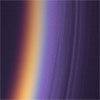
|
 |
|
Thursday:
December 16, 2004 | |
0228 GMT |
 |
Symphony of colors in the Tarantula Nebula
The Tarantula Nebula is the most vigorous star forming region known in the local Universe. This amazing panorama was created by a young amateur astronomer from the original image was taken by the Hubble Space Telescope.
 FULL STORY FULL STORY
 |  |
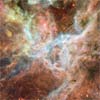
|
 |
Earth's safe zone got hot during legendary storms
A NASA-funded study found a region between radiation belts surrounding the Earth is not as benign as once thought. The region was considered a safe zone for satellites in "Middle Earth" orbits, because of relatively small amounts of radiation.
 FULL STORY FULL STORY
 |  |
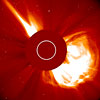
|
 |
Pulsar gives insight into ultra dense matter
A long look at a young pulsar with NASA's Chandra X-ray Observatory revealed unexpectedly rapid cooling, which suggests that it contains much denser matter than previously expected. The pulsar's cool temperature and the vast magnetic web of high-energy particles that surrounds it have implications for the theory of nuclear matter and the origin of magnetic fields in cosmic objects.
 FULL STORY FULL STORY
 |  |
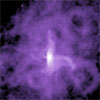
|
 |
|
Wednesday:
December 15, 2004 | |
0412 GMT |
 |
Rocket trouble stalls launch of Deep Impact mission
A manufacturing error discovered in a part of the Boeing Delta 2 rocket to launch NASA's Deep Impact comet striker will force on-pad repairs, further delaying liftoff that must occur during an unflexible one-month window.
 FULL STORY FULL STORY
 PREVIOUS DEEP IMPACT STORIES PREVIOUS DEEP IMPACT STORIES
 |  |
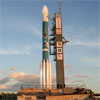
|
 |

Additional coverage for subscribers:
 VIDEO:
OVERVIEW OF NASA'S DEEP IMPACT MISSION QT VIDEO:
OVERVIEW OF NASA'S DEEP IMPACT MISSION QT
 VIDEO:
LEAD RESEARCHER PREVIEWS DEEP IMPACT SCIENCE QT VIDEO:
LEAD RESEARCHER PREVIEWS DEEP IMPACT SCIENCE QT
 VIDEO:
WATCH DEEP IMPACT PRE-FLIGHT NEWS BRIEFING QT VIDEO:
WATCH DEEP IMPACT PRE-FLIGHT NEWS BRIEFING QT
 SUBSCRIBE NOW SUBSCRIBE NOW

|
Atlas 5 rocket ready to haul TV satellite into Earth orbit
After a hiatus in flights of the new Atlas 5 rocket while Lockheed Martin flew its inventory of older-style boosters, focus returns to the next generation Friday with an early morning launch from Cape Canaveral.
 PREVIEW STORY PREVIEW STORY
 |  |
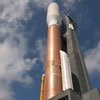
|
 |
Investigations picked for Mars Science Laboratory
NASA has selected eight proposals to provide instrumentation and associated science investigations for the mobile Mars Science Laboratory rover, scheduled for launch in 2009. The MSL mission will deliver a mobile la to the surface of Mars to explore a local region as a potential habitat for past or present life.
 FULL STORY FULL STORY
 |  |

|
 |
Aura craft sheds new light on air quality, ozone hole
NASA scientists announced the agency's Aura spacecraft is providing the first daily, direct global measurements of low-level ozone and many other pollutants affecting air quality.
 FULL STORY FULL STORY
 |  |
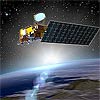
|
 |
|
Tuesday:
December 14, 2004 | |
0120 GMT |
 |
Mars rovers spot water-clue mineral, frost, clouds
Scientists have identified a water-signature mineral called goethite in bedrock that the NASA's Mars rover Spirit examined in the "Columbia Hills," one of the mission's surest indicators yet for a wet history on Spirit's side of Mars.
 FULL STORY FULL STORY
 OPPORTUNITY EXITS ENDURANCE CRATER OPPORTUNITY EXITS ENDURANCE CRATER
 |  |
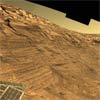
|
 |

Additional coverage for subscribers:
 VIDEO:
MARS ROVER UPDATE FROM SCIENTIST LEADER QT VIDEO:
MARS ROVER UPDATE FROM SCIENTIST LEADER QT
 SUBSCRIBE NOW SUBSCRIBE NOW

|
Cassini has another successful Titan flyby
The Cassini spacecraft completed a successful rendezvous with Saturn's moon Titan on Monday. This was the last pass before the European Space Agency's Huygens probe is sprung loose from Cassini on Christmas Eve.
 FULL STORY FULL STORY
 CASSINI NEWS ARCHIVE CASSINI NEWS ARCHIVE
 |  |

|
 |
It's official: O'Keefe announces resignation
Administrator Sean O'Keefe, who over the past three years led the National Aeronautics and Space Administration through an aggressive and comprehensive management transformation and helped the agency through one of its most painful tragedies, resigned Monday.
 FULL STORY FULL STORY
 |  |
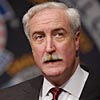
|
 |
New Cassini picture shows rings in extraordinary detail
This fantastic close-up of Saturn's outer C ring shows large and sharp changes in brightness across the rings, owing to the extreme variations in ring particle concentrations at different distances from the planet.
 FULL STORY FULL STORY
 |  |
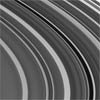
|
 |
|
Monday:
December 13, 2004 | |
0358 GMT |
 |
Delta 4-Heavy rocket launch faces extended hold
Equipment problems and scheduling conflicts with a rival rocket have combined to keep Boeing's Delta 4-Heavy booster grounded on its Cape Canaveral launch pad until sometime next week.
 MISSION STATUS CENTER - live updates! MISSION STATUS CENTER - live updates!
 PREVIOUS DELTA 4-HEAVY COVERAGE PREVIOUS DELTA 4-HEAVY COVERAGE
 PHOTO GALLERY: SUNDAY LAUNCH PREPS PHOTO GALLERY: SUNDAY LAUNCH PREPS
 |  |
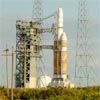
|
 |
ESA astronaut to fly on Italian Soyuz mission
Roberto Vittori will be the next ESA astronaut to fly to the International Space Station, on the 10-day Italian Soyuz mission, scheduled to be launched on April 15 next year from the Baikonur Cosmodrome in Kazakhstan. The mission is called ENEIDE and takes its name from the epic tale written by the Latin poet Virgil in the 1st century BC. This story tells of the journey of Aeneas from Troy to Italy and the foundation of Rome.
 FULL STORY FULL STORY
 |  |
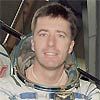
|
 |
NASA's famed B-52B 'mothership' to retire
Having dropped advanced flight research vehicles rather than bombs over an illustrious career
spanning nearly a half century, NASA's B-52B "mothership" air-launch aircraft is being retired.
 FULL STORY FULL STORY
 |  |
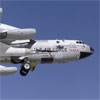
|
 |
|
Sunday:
December 12, 2004 | |
0001 GMT |
 |
Inaugural Delta 4-Heavy rocket to launch today
A new countdown is underway this morning for the launch of Boeing's first Delta 4-Heavy rocket. The 23-story booster is scheduled for blastoff at 2:32 p.m. EST (1932 GMT) from Cape Canaveral, Florida.
 MISSION STATUS CENTER - live updates! MISSION STATUS CENTER - live updates!
 PREVIOUS DELTA 4-HEAVY COVERAGE PREVIOUS DELTA 4-HEAVY COVERAGE
 |  |

|
 |
Technical trouble scrubbed Saturday's launch try
The maiden flight of the Boeing Delta 4-Heavy rocket was scrubbed Saturday because of trouble with the master sequencer that controls the crucial final seconds of the countdown.
 FULL STORY FULL STORY
 PHOTO GALLERY: SERVICE TOWER ROLLBACK PHOTO GALLERY: SERVICE TOWER ROLLBACK
 PHOTO GALLERY: PHOTOGRAPHERS AT THE PAD PHOTO GALLERY: PHOTOGRAPHERS AT THE PAD
 |  |

|
 |
Reports: NASA chief Sean O'Keefe may leave agency
NASA Administrator Sean O'Keefe, a self-described "budgeteer" who was brought in to curb space station cost overruns and who later helped formulate a new presidential initiative to send astronauts back to the moon and on to Mars, may be considering a job in academia, according to newspaper and internet accounts.
 FULL STORY FULL STORY
 |  |
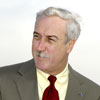
|
 |
From Saturn's dark side
As Cassini swung around to the dark side of the planet during its first close passage after orbit insertion, the intrepid spacecraft spied three ring moons -- Mimas, Janus and Prometheus -- whizzing around the planet.
 FULL STORY FULL STORY
 |  |
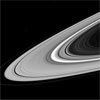
|
 |
|
Saturday:
December 11, 2004 | |
0412 GMT |
 |
Delta 4-Heavy rocket poised for debut today
America's new heavy-lifting rocket takes its much-anticipated test flight today. Boeing's inaugural Delta 4-Heavy rocket is scheduled to make its thunderous departure from Cape Canaveral's pad 37B at 2:31 p.m. EST (1931 GMT) while riding 1.9-million pounds of fiery thrust generated by its three hydrogen-fueled engines. Follow the countdown in our live status center:
 MISSION STATUS CENTER - live updates! MISSION STATUS CENTER - live updates!
 PREVIOUS DELTA 4-HEAVY COVERAGE PREVIOUS DELTA 4-HEAVY COVERAGE
 PHOTO GALLERY: SERVICE TOWER ROLLBACK PHOTO GALLERY: SERVICE TOWER ROLLBACK
 PHOTO GALLERY: PHOTOGRAPHERS AT THE PAD PHOTO GALLERY: PHOTOGRAPHERS AT THE PAD
 |  |

|
 |

Additional coverage for subscribers:
 AUDIO:
THURSDAY'S 68-MINUTE PRE-LAUNCH NEWS CONFERENCE QT AUDIO:
THURSDAY'S 68-MINUTE PRE-LAUNCH NEWS CONFERENCE QT
 VIDEO:
ANIMATION PROVIDES PREVIEW OF A DELTA 4-HEAVY LAUNCH QT VIDEO:
ANIMATION PROVIDES PREVIEW OF A DELTA 4-HEAVY LAUNCH QT
 VIDEO:
RE-LIVE THE INAUGURAL DELTA 4 LAUNCH FROM 2002 QT VIDEO:
RE-LIVE THE INAUGURAL DELTA 4 LAUNCH FROM 2002 QT
 VIDEO:
ON-PAD FLIGHT READINESS ENGINE FIRING TEST QT VIDEO:
ON-PAD FLIGHT READINESS ENGINE FIRING TEST QT
 VIDEO:
TAKE TOUR OF LAUNCH PAD 37B QT VIDEO:
TAKE TOUR OF LAUNCH PAD 37B QT
 SUBSCRIBE NOW SUBSCRIBE NOW

|
'Solar ultrasound' waves discovered by satellite
The Sun's atmosphere is filled with ultrasound-like waves that may help solve decades-old mysteries about the Sun and space weather, according to Southwest Research Institute scientists who found the waves in data from NASA's TRACE spacecraft.
 FULL STORY FULL STORY
 |  |

|
 |
|
Friday:
December 10, 2004 | |
0240 GMT |
 |
Delta 4-Heavy's demo flight critical to military missions
America's new heavy-lifting rocket takes its much-anticipated test flight Saturday, if Mother Nature cooperates. The Boeing Delta 4-Heavy rocket was supposed to launch today, but the forecast for strong winds and stormy weather at Cape Canaveral postponed the liftoff by 24 hours.
 FULL STORY FULL STORY
 THURSDAY'S SCRUB STORY THURSDAY'S SCRUB STORY
 MISSION STATUS CENTER - updates! MISSION STATUS CENTER - updates!
 |  |
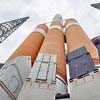
|
 |

Additional coverage for subscribers:
 AUDIO:
THURSDAY'S 68-MINUTE PRE-LAUNCH NEWS CONFERENCE QT AUDIO:
THURSDAY'S 68-MINUTE PRE-LAUNCH NEWS CONFERENCE QT
 VIDEO:
ANIMATION PROVIDES PREVIEW OF A DELTA 4-HEAVY LAUNCH QT VIDEO:
ANIMATION PROVIDES PREVIEW OF A DELTA 4-HEAVY LAUNCH QT
 VIDEO:
RE-LIVE THE INAUGURAL DELTA 4 LAUNCH FROM 2002 QT VIDEO:
RE-LIVE THE INAUGURAL DELTA 4 LAUNCH FROM 2002 QT
 VIDEO:
ON-PAD FLIGHT READINESS ENGINE FIRING TEST QT VIDEO:
ON-PAD FLIGHT READINESS ENGINE FIRING TEST QT
 VIDEO:
TAKE TOUR OF LAUNCH PAD 37B QT VIDEO:
TAKE TOUR OF LAUNCH PAD 37B QT
 SUBSCRIBE NOW SUBSCRIBE NOW

|
Countdown gets underway many hours before blastoff
Workers pulling night-owl duty will begin countdown activities in the predawn hours Saturday, prepping the debut Delta 4-Heavy rocket, its Cape launch site and ground systems for fueling and liftoff.
 FULL STORY FULL STORY
 DELTA 4-HEAVY ROCKET FACT SHEET DELTA 4-HEAVY ROCKET FACT SHEET
 DEMOSAT AND NANOSAT PAYLOAD INFO DEMOSAT AND NANOSAT PAYLOAD INFO
 |  |
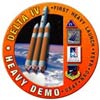
|
 |
Spitzer, Hubble capture evolving planetary systems
Two of NASA's Great Observatories, the Spitzer Space Telescope and the Hubble Space Telescope, have provided astronomers an unprecedented look at dusty planetary debris around stars the size of our sun.
 FULL STORY FULL STORY
 |  |
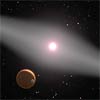
|
 |
|
Thursday:
December 9, 2004 | |
0127 GMT |
 |
Report: Shuttle servicing of Hubble is best option
To ensure continuation of the extraordinary scientific output of the Hubble Space Telescope and to prepare for its eventual de-orbiting, NASA should send a space shuttle mission, not a robotic one, says a new congressionally requested report from the National Academies' National Research Council.
 FULL STORY FULL STORY
 |  |

|
 |
Saturn's moon Iapetus as you've never seen it
New details on Iapetus are illuminated by reflected light from Saturn in this revealing Cassini image. Never-before-seen features on the Saturn-facing part of Iapetus' bright trailing hemisphere are visible for the first time.
 FULL STORY FULL STORY
 CASSINI NEWS ARCHIVE CASSINI NEWS ARCHIVE
 |  |
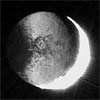
|
 |
|
Wednesday:
December 8, 2004 | |
0350 GMT |
 |
The Heavy: Triple-sized Delta 4 rocket to debut
After years of development and 366 days standing on the launch pad, Boeing's behemoth Delta 4-Heavy rocket flies its maiden mission Friday to showcase its proficiency and character in hauling hefty cargos to space.
 MISSION PREVIEW STORY MISSION PREVIEW STORY
 |  |

|
 |
Ultra-sharp camera readied for next Mars orbiter
The camera that will take thousands of the sharpest, most detailed pictures of Mars ever produced from an orbiting spacecraft was delivered this week for installation on NASA's Mars Reconnaissance Orbiter.
 FULL STORY FULL STORY
 |  |
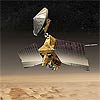
|
 |
|
Tuesday:
December 7, 2004 | |
0001 GMT |
 |
Repair techniques not required for shuttle return
NASA remains on track for launching the shuttle Discovery on the first post-Columbia mission next May or June, managers said Monday. While certified techniques for on-orbit repair of tile or wing leading edge damage may not be available by then, efforts to minimize foam debris impacts, coupled with a variety of other safety upgrades and the "safe haven" provided by the space station, give managers confidence the shuttle can safely return to flight sometime next spring.
 FULL STORY FULL STORY
 |  |
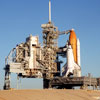
|
 |

Additional coverage for subscribers:
 VIDEO:
MONDAY'S SHUTTLE PROGRAM NEWS CONFERENCE QT VIDEO:
MONDAY'S SHUTTLE PROGRAM NEWS CONFERENCE QT
 VIDEO:
FOOTAGE OF RETURN TO FLIGHT WORK QT VIDEO:
FOOTAGE OF RETURN TO FLIGHT WORK QT
 SUBSCRIBE NOW SUBSCRIBE NOW

|
Atlas 5 rocket topped with payload for Dec. 17 launch
A commercial television broadcast satellite and the rocket that will boost it into space -- Lockheed Martin's Atlas 5 rocket -- were joined together Monday at Cape Canaveral.
 FULL STORY FULL STORY
 MISSION STATUS CENTER MISSION STATUS CENTER
 |  |
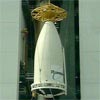
|
 |
|
Monday:
December 6, 2004 | |
0211 GMT |
 |
Explosions in majestic spiral galaxy beauties
Images of beautiful galaxies, and in particular of spiral brethren of our own Milky Way, leaves no one unmoved. It is difficult indeed to resist the charm of these impressive grand structures.
 FULL STORY FULL STORY
 |  |
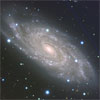
|
 |
|
Sunday:
December 5, 2004 | |
0045 GMT |
 |
Cassini captures Saturn moon red-handed
Stealing is a crime on Earth, but at Saturn, apparently it is routine. The Cassini spacecraft has witnessed Saturn's moon Prometheus snatching particles from one of Saturn's rings.
 FULL STORY FULL STORY
 |  |
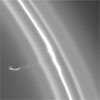
|
 |
Intelsat regains control of IA-7 satellite
Intelsat, Ltd. announced Friday that it is pursuing a recovery mission of the Intelsat Americas 7 satellite, which experienced a sudden and unusual electrical distribution anomaly on November 28. As a result of an intensive recovery effort by the Intelsat technical team, contact and control of the satellite has been regained.
 FULL STORY FULL STORY
 |  |
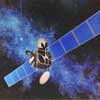
|
 |
OTHER HEADLINES Additional stories today
|
 |
Wind, current changes linked to Indian Ocean warming -- A NASA study suggests changing winds and currents in the Indian Ocean during the 1990s contributed to the observed warming of the ocean during that period. The findings, published in a recent issue of Geophysical Research Letters, have potential implications for long-term regional climate variability.
|
 |
|
Saturday:
December 4, 2004 | |
0001 GMT |
 |
John Young is retiring
More than 40 years after becoming an astronaut, American hero John Young is retiring from NASA this month. The 74-year-old had an extraordinary career and was the first person to fly in space six times during the Gemini, Apollo and shuttle programs. He walked on the moon in 1972 and commanded the maiden flight of Columbia in 1981.
 FULL STORY FULL STORY
 |  |
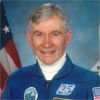
|
 |
Space shuttle launch times no longer a secret
NASA has quietly lifted post-9/11 security restrictions that included keeping shuttle launch times secret until the day before liftoff. In the wake of the terrorists attacks, NASA managers imposed unprecedented security procedures similar in many respects to those once employed for classified military flights.
 FULL STORY FULL STORY
 |  |
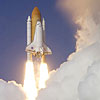
|
 |
|
Friday:
December 3, 2004 | |
0302 GMT |
 |
Saturn's ring gap
An intriguing knotted ringlet within the Encke Gap is the main attraction in this Cassini image. The Encke Gap is a small division near the outer edge of Saturn's rings that is about 190 miles wide. The tiny moon Pan orbits within the gap and maintains it.
 FULL STORY FULL STORY
 |  |
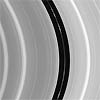
|
 |
Fire reported inside NASA's Vehicle Assembly Building
A small fire broke out Thursday afternoon inside Kennedy Space Center's cavernous Vehicle Assembly Building. The 52-story landmark facility was built in the 1960s to assemble the giant Saturn 5 moon rockets and has been used for the past quarter-century for space shuttles.
 FULL STORY FULL STORY
 |  |
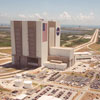
|
 |
|
Thursday:
December 2, 2004 | |
0348 GMT |
 |
Did our sun capture
alien worlds?
Computer simulations show a close encounter with a passing star about 4 billion years ago may have given our solar system its abrupt edge and put small, alien worlds into distant orbits around our sun.
 FULL STORY FULL STORY
 |  |
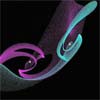
|
 |
Cape's Complex 36 receives its final Atlas booster
Lockheed Martin erected its last Atlas rocket at Complex 36 on Wednesday as the historic Cape Canaveral launch site nears retirement after four decades of use.
 MISSION STATUS CENTER MISSION STATUS CENTER
 |  |
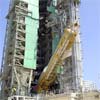
|
 |
Gazing down on Saturn
The Cassini spacecraft pierced the ring plane and rounded Saturn a few weeks ago, capturing these pictures that NASA has released showing the dark portion of the planet's majestic rings.
 FULL STORY FULL STORY
 |  |
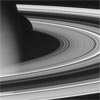
|
 |
OTHER HEADLINES Additional stories today
|
 |
NASA study finds glacier doing double time -- A NASA-funded study found the world's fastest glacier, Greenland's Jakobshavn Isbrae, doubled its speed of ice flow between 1997 and 2003. The study provides key evidence of newly discovered relationships between ice sheets, sea level rise and climate warming. The study appears in this week's issue of the journal Nature.
|
 |
|
Wednesday:
December 1, 2004 | |
0001 GMT |
 |
A baby galaxy uncovered in a grown-up universe
Using the Hubble Space Telescope, a scientist has identified what may be the youngest galaxy ever seen in the universe. By cosmological standards it is a mere toddler. Called I Zwicky 18, it may be as young as 500 million years old. Comparatively, our Milky Way galaxy is about 12 billion years old, the typical age of galaxies across the universe.
 FULL STORY FULL STORY
 |  |
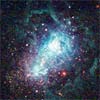
|
 |
New GPS enters service
The latest Global Positioning System satellite, launched from Cape Canaveral Air Force Station in early November, has been declared fully operational for military and civilian navigation users around the globe.
 FULL STORY FULL STORY
 LAUNCH COVERAGE LAUNCH COVERAGE
 |  |

|
 |
OTHER HEADLINES Additional stories today
|
 |
New home for astronomers -- For almost 100 years, Caltech has been at the forefront of astronomy and astrophysics, pioneering research that has led to greater understanding of the earth, the solar system, and the universe. Now the Institute is about to help its world-renowned astronomers and other investigators continue their groundbreaking discoveries well into the 21st century.
|
 |
|
Tuesday:
November 30, 2004 | |
0457 GMT |
 |
Nature's canvas at Saturn
In a splendid portrait created by light and gravity, Saturn's lonely moon Mimas is seen against the cool, blue-streaked backdrop of Saturn's northern hemisphere. Delicate shadows cast by the rings arc gracefully across the planet, fading into darkness on Saturn's night side.
 FULL STORY FULL STORY
 |  |
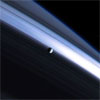
|
 |
Communications satellite serving the Americas fails
The Intelsat Americas 7 communications satellite, formerly known as Telstar 7, suffered a major malfunction Sunday that led to "permanent loss" of the spacecraft. The five-year-old satellite was used for television broadcasting and other services over the U.S., Central America and parts of South America.
 FULL STORY FULL STORY
 |  |

|
 |
OTHER HEADLINES Additional stories today
|
 |
Lockheed to build five satellites for Rainbow -- Lockheed Martin has been awarded a contract by Rainbow DBS to build its next five geostationary telecommunications satellites, designated Rainbow Ka-1 through Rainbow Ka-5.
|
 |
|
Monday:
November 29, 2004 | |
1141 GMT |
 |
International Space Station crew takes a ride in Soyuz
The two-man crew of the International Space Station left its orbital home Monday, taking a ride in a Russian Soyuz capsule to move the craft from one docking port to another. The trip -- albeit brief -- lasted 21 minutes.
 FULL STORY FULL STORY
 EARLIER STATUS REPORT EARLIER STATUS REPORT
 |  |
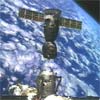
|
 |

Additional coverage for subscribers:
 VIDEO:
SOYUZ CAPSULE UNDOCKS FROM PIRS MODULE QT VIDEO:
SOYUZ CAPSULE UNDOCKS FROM PIRS MODULE QT
 VIDEO:
ROLL MANEUVER COMPLETED BY THE CAPSULE QT VIDEO:
ROLL MANEUVER COMPLETED BY THE CAPSULE QT
 VIDEO:
SPECTACULAR VIEWS OF SOYUZ FLYING OVER EARTH QT VIDEO:
SPECTACULAR VIEWS OF SOYUZ FLYING OVER EARTH QT
 VIDEO:
SUCCESSFUL DOCKING TO THE RUSSIAN ZARYA MODULE QT VIDEO:
SUCCESSFUL DOCKING TO THE RUSSIAN ZARYA MODULE QT
 VIDEO:
VIEWS OF APPROACH AND DOCKING FROM ISS CAMERAS QT VIDEO:
VIEWS OF APPROACH AND DOCKING FROM ISS CAMERAS QT
 SUBSCRIBE NOW SUBSCRIBE NOW

|
Precocious black holes challenge theories
NASA's Chandra X-ray Observatory has obtained definitive evidence that a distant quasar formed less than a billion years after the Big Bang contains a fully-grown supermassive black hole generating energy at the rate of twenty trillion Suns.
 FULL STORY FULL STORY
 |  |

|
 |
|
Sunday:
November 28, 2004 | |
0142 GMT |
 |
Battered and grooved: Saturn's moon Tethys
Having now passed closer to Tethys than the Voyager 2 spacecraft, Cassini has returned the best-ever natural color view of this icy Saturnian moon.
 FULL STORY FULL STORY
 |  |
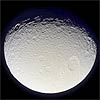
|
 |
|
Saturday:
November 27, 2004 | |
0250 GMT |
 |
Seismic shaking erased small craters on asteroid
University of Arizona scientists have discovered why Eros, the largest near-Earth asteroid, has so few small craters. The Near Earth Asteroid Rendezvous (NEAR) spacecraft mission orbited Eros for up-close research.
 FULL STORY FULL STORY
 |  |
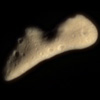
|
 |
OTHER HEADLINES Additional stories today
|
 |
Next International Space Station crew named -- Veteran NASA astronaut John Phillips and seasoned Russian cosmonaut Sergei Krikalev are the next crew of the International Space Station. Their six-month mission is set for launch in April 2005.

NASA honors memory of Mission Control veteran -- Donald R. Puddy, 67, whose 31-year career with NASA spanned the Apollo, Skylab and Space Shuttle programs, died this week in Houston following a lengthy illness. Puddy joined NASA's Johnson Space Center in 1964 and spent 22 years as a key leader of human space flights in the Mission Control Center.
|
 |
|
Friday:
November 26, 2004 | |
0001 GMT |
 |
Space Council paves way for European space program
The first ever European "Space Council" was held in Brussels Thursday. This was a major political milestone for Europe in Space, offering ministers representing the 27 European Union and/or European Space Agency Member States the first opportunity to jointly discuss the development of a coherent overall European space program.
 FULL STORY FULL STORY
 |  |
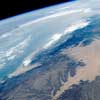
|
 |
|
Thursday:
November 25, 2004 | |
0001 GMT |
 |
Hovering over Titan
A mosaic of nine processed images recently acquired during Cassini's first very close flyby of Saturn's moon Titan constitutes the most detailed full-disc view of the mysterious moon. The mosaic was released this week.
 FULL STORY FULL STORY
 |  |
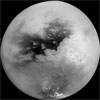
|
 |
Deep Impact launch postponed into 2005
Launch of NASA's Deep Impact spacecraft that will blast a small projectile into the heart of Comet Tempel 1 has been delayed from December 30 to give engineers more time to complete pre-flight work on mission software, the space agency announced Wednesday.
 FULL STORY FULL STORY
 |  |

|
 |
|
Wednesday:
November 24, 2004 | |
0124 GMT |
 |
Countdown dress rehearsal a success for Atlas 5 rocket
Lockheed Martin's next Atlas 5 rocket and its Cape Canaveral launch team completed a major test Tuesday in preparation for next month's liftoff to deliver a commercial communications satellite into space.
 FULL STORY FULL STORY
 |  |
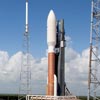
|
 |
Breathtaking vista of Tethys
This dazzling view from Cassini looks beyond gigantic storms near Saturn's south pole to the small but clear disc of Tethys. Clouds and ribbons of gas swirl about in the planet's atmosphere in the foreground, while a tremendous chasm is visible on the icy moon.
 FULL STORY FULL STORY
 |  |
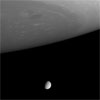
|
 |
|
Tuesday:
November 23, 2004 | |
0043 GMT |
 |
Deep Impact's launcher begins to take shape
The Delta launch team at Cape Canaveral had little time to rest after Saturday's successful liftoff of NASA's Swift observatory as the crew begin erecting another rocket Monday that will dispatch an extraordinary mission to Comet Tempel 1 on December 30.
 FULL STORY FULL STORY
 |  |
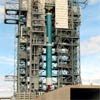
|
 |
Cassini image shows Saturn moon with a real shiner
Saturn's moon Rhea shows off the moon equivalent of a black eye -- a bright, rayed crater near its eastern limb -- in this picture from the Cassini mission released Monday. Rhea is about half the size of Earth's moon.
 FULL STORY FULL STORY
 |  |
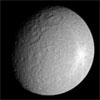
|
 |
Countdown simulation underway for Atlas 5
A Lockheed Martin Atlas 5 rocket was rolled from the assembly hangar to the launch pad Monday morning for a countdown dress rehearsal in preparation for its December 16 blastoff from Cape Canaveral.
 MISSION STATUS CENTER MISSION STATUS CENTER
 |  |
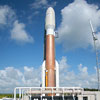
|
 |
|
Monday:
November 22, 2004 | |
0226 GMT |
 |
Photo collection: Successful launch of Swift spacecraft
NASA's Swift gamma-ray observatory was launched aboard a Boeing Delta 2 rocket from Cape Canaveral at 12:16 p.m. EST Saturday. These photo galleries follow the day's activities and successful blastoff into crystal-clear skies.
 PHOTO GALLERY: SERVICE TOWER ROLLBACK PHOTO GALLERY: SERVICE TOWER ROLLBACK
 PHOTO GALLERY: DELTA 2 ROCKET LIFTOFF PHOTO GALLERY: DELTA 2 ROCKET LIFTOFF
 |  |
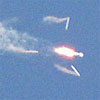
|
 |

Additional coverage for subscribers:
 VIDEO:
RARE CLOSE-UP VIEW OF VERNIER ENGINE IGNITION QT VIDEO:
RARE CLOSE-UP VIEW OF VERNIER ENGINE IGNITION QT
 VIDEO:
ENGINEERING CAMERA VIEW OF VEHICLE LIFTING OFF QT VIDEO:
ENGINEERING CAMERA VIEW OF VEHICLE LIFTING OFF QT
 VIDEO:
DRAMATIC LIFTOFF FOOTAGE FROM LAUNCH PAD TOWER QT VIDEO:
DRAMATIC LIFTOFF FOOTAGE FROM LAUNCH PAD TOWER QT
 VIDEO:
PRESS SITE 1 CAMERA FOLLOWS THE ASCENT QT VIDEO:
PRESS SITE 1 CAMERA FOLLOWS THE ASCENT QT
 VIDEO:
PLAYALINDA BEACH CAMERA VIEW QT VIDEO:
PLAYALINDA BEACH CAMERA VIEW QT
 VIDEO:
UCS 3 CAMERA TRACKING SITE ANGLE QT VIDEO:
UCS 3 CAMERA TRACKING SITE ANGLE QT
 VIDEO:
ANOTHER TRACKING CAMERA VIEW QT VIDEO:
ANOTHER TRACKING CAMERA VIEW QT
 SUBSCRIBE NOW SUBSCRIBE NOW

|
OTHER HEADLINES Additional stories today
|
 |
Team to develop proposed railway space observatory -- Boeing is part of a NASA-led team of university and industry partners developing a preliminary design for the Space Infrared Inteferometric Telescope (SPIRIT), with components that will move along a structural beam in space like railcars on a track.

MESSENGER spacecraft completes third maneuver -- MESSENGER completed its third trajectory correction maneuver since launch - and its last of 2004 - trimming its speed and tweaking its course toward the Earth flyby next August. MESSENGER is a scientific investigation of the planet Mercury, and the first NASA mission designed to orbit the planet closest to the Sun.
|
 |
|
Sunday:
November 21, 2004 | |
0001 GMT |
 |
Spacecraft launched to observe cataclysmic blasts
NASA launched a $250 million quick-response satellite Saturday to study enigmatic gamma ray flashes from brief-but-titanic deep space explosions that may be the "death cries" of massive stars imploding to form black holes.
 FULL STORY FULL STORY
 MISSION STATUS CENTER MISSION STATUS CENTER
 |  |

|
 |

Additional coverage for subscribers:
 VIDEO:
DELTA ROCKET BLASTS OFF WITH SWIFT QT VIDEO:
DELTA ROCKET BLASTS OFF WITH SWIFT QT
 VIDEO:
COCOA BEACH TRACKING CAMERA VIDEO OF LAUNCH QT VIDEO:
COCOA BEACH TRACKING CAMERA VIDEO OF LAUNCH QT
 VIDEO:
CAMCORDER VIEW OF LAUNCH FROM CAPE PRESS SITE QT VIDEO:
CAMCORDER VIEW OF LAUNCH FROM CAPE PRESS SITE QT
 VIDEO:
ONBOARD ROCKET CAMERA SHOWS NOSE CONE JETTISON QT VIDEO:
ONBOARD ROCKET CAMERA SHOWS NOSE CONE JETTISON QT
 VIDEO:
ONBOARD ROCKET CAMERA SHOWS DEPLOYMENT OF SWIFT QT VIDEO:
ONBOARD ROCKET CAMERA SHOWS DEPLOYMENT OF SWIFT QT
 VIDEO:
MOBILE SERVICE TOWER ROLLED BACK BEFORE DAWN QT VIDEO:
MOBILE SERVICE TOWER ROLLED BACK BEFORE DAWN QT
 VIDEO:
SWIFT'S LAUNCH CAMPAIGN SHOWN WITH NARRATION QT VIDEO:
SWIFT'S LAUNCH CAMPAIGN SHOWN WITH NARRATION QT
 VIDEO:
ENTIRE ON-PAD ASSEMBLY OF ROCKET WITH NARRATION QT VIDEO:
ENTIRE ON-PAD ASSEMBLY OF ROCKET WITH NARRATION QT

 VIDEO:
TUESDAY'S PRE-LAUNCH NEWS CONFERENCE QT VIDEO:
TUESDAY'S PRE-LAUNCH NEWS CONFERENCE QT
 VIDEO:
INTERNATIONAL SCIENTISTS DISCUSS SWIFT QT VIDEO:
INTERNATIONAL SCIENTISTS DISCUSS SWIFT QT
 VIDEO:
NEWS CONFERENCE PREVIEWS THE SWIFT MISSION QT VIDEO:
NEWS CONFERENCE PREVIEWS THE SWIFT MISSION QT
 VIDEO:
DELTA 2 ROCKET FIRST STAGE IS ERECTED ON PAD 17A QT VIDEO:
DELTA 2 ROCKET FIRST STAGE IS ERECTED ON PAD 17A QT
 VIDEO:
SOLID ROCKET BOOSTERS ARE RAISED INTO TOWER QT VIDEO:
SOLID ROCKET BOOSTERS ARE RAISED INTO TOWER QT
 VIDEO:
MOBILE SERVICE TOWER MOVES SRBS INTO PLACE QT VIDEO:
MOBILE SERVICE TOWER MOVES SRBS INTO PLACE QT
 VIDEO:
NOSE CONE HOISTED INTO PAD CLEANROOM QT VIDEO:
NOSE CONE HOISTED INTO PAD CLEANROOM QT
 SUBSCRIBE NOW SUBSCRIBE NOW

|
|
Saturday:
November 20, 2004 | |
0158 GMT |
 |
Swift observatory cleared for Saturday launch
With the Boeing Delta 2 rocket's safety system fixed, NASA's Swift gamma-ray observatory is scheduled for blastoff at 12:10 p.m. EST (1710 GMT) Saturday from Cape Canaveral, Florida. Swift will begin its two-year mission to detect the most powerful explosions in the universe.
 MISSION STATUS CENTER - live updates! MISSION STATUS CENTER - live updates!
 LAUNCH EVENTS TIMELINE LAUNCH EVENTS TIMELINE
 GROUND TRACK MAP GROUND TRACK MAP
 |  |

|
 |
Human, robotic programs share lessons learned
Members of NASA's human and robotic programs are cooperating in new ways to support the Vision for Space Exploration. The Vision calls for a "building block" strategy of human and robotic missions to reach new exploration goals. The first step in the Vision is returning the space shuttle safely to flight.
 FULL STORY FULL STORY
 |  |

|
 |
|
Friday:
November 19, 2004 | |
0320 GMT |
 |
Saturday launch at the earliest for Swift satellite
Suspect parts in the Boeing Delta 2 rocket's safety system must be replaced, delaying until at least Saturday the launch of NASA's Swift gamma-ray observatory on its two-year mission to detect the most powerful explosions in the universe.
 MISSION STATUS CENTER - live updates! MISSION STATUS CENTER - live updates!
 LAUNCH EVENTS TIMELINE LAUNCH EVENTS TIMELINE
 GROUND TRACK MAP GROUND TRACK MAP
 |  |

|
 |

Additional coverage for subscribers:
 VIDEO:
TUESDAY'S PRE-LAUNCH NEWS CONFERENCE QT VIDEO:
TUESDAY'S PRE-LAUNCH NEWS CONFERENCE QT
 VIDEO:
INTERNATIONAL SCIENTISTS DISCUSS SWIFT QT VIDEO:
INTERNATIONAL SCIENTISTS DISCUSS SWIFT QT

 VIDEO:
NEWS CONFERENCE PREVIEWS THE SWIFT MISSION QT VIDEO:
NEWS CONFERENCE PREVIEWS THE SWIFT MISSION QT
 VIDEO:
DELTA 2 ROCKET FIRST STAGE IS ERECTED ON PAD 17A QT VIDEO:
DELTA 2 ROCKET FIRST STAGE IS ERECTED ON PAD 17A QT
 VIDEO:
SOLID ROCKET BOOSTERS ARE RAISED INTO TOWER QT VIDEO:
SOLID ROCKET BOOSTERS ARE RAISED INTO TOWER QT
 VIDEO:
MOBILE SERVICE TOWER MOVES SRBS INTO PLACE QT VIDEO:
MOBILE SERVICE TOWER MOVES SRBS INTO PLACE QT
 VIDEO:
NOSE CONE HOISTED INTO PAD CLEANROOM QT VIDEO:
NOSE CONE HOISTED INTO PAD CLEANROOM QT
 SUBSCRIBE NOW SUBSCRIBE NOW

|
A closer look at black holes
An international team led by an Edinburgh astronomer have discovered that by studying polarized light from black holes they can focus much more closely on what exactly is going on around them.
 FULL STORY FULL STORY
 |  |

|
 |
Boeing to test experimental rocket engine
With an eye toward revolutionary new rocket engine systems, engineers from Rocketdyne have begun final preparations for testing a futuristic engine at the Stennis Space Center in Mississippi. The engine, dubbed the Integrated Powerhead Demonstration, combines the very latest in rocket engine propulsion technologies.
 FULL STORY FULL STORY
 |  |
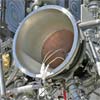
|
 |
OTHER HEADLINES Additional stories today
|
 |
Crew members added to STS-121 -- NASA astronauts Lisa Nowak and Stephanie Wilson are joining the crew of the second space shuttle return to flight mission planned for launch in 2005.
|
 |
|
Thursday:
November 18, 2004 | |
0318 GMT |
 |
Swift space observatory launch delayed again
Engineering teams continue to troubleshoot concerns with the safety system aboard the Boeing Delta 2 rocket that will carry NASA's Swift gamma-ray observatory into space, postponing liftoff from Cape Canaveral until Friday at the earliest.
 MISSION STATUS CENTER MISSION STATUS CENTER
 |  |

|
 |
Boeing to use X-43A results for future hypersonic ideas
Information gained from Tuesday's record-setting flight of NASA's Hyper-X research vehicle will be used by Boeing as it designs the future of flight.
 FULL STORY FULL STORY
 |  |
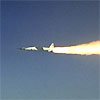
|
 |
Cassini sees Atlas, Pandora and Janus orbiting Saturn
Saturn hosts its own miniature solar system, with an entourage of more than 30 moons. This image shows Saturn's A and F rings, along with three of the moons that orbit close to them.
 FULL STORY FULL STORY
 |  |
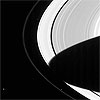
|
 |
OTHER HEADLINES Additional stories today
|
 |
NASA selects Exploration Systems proposals -- NASA's Exploration Systems Mission Directorate selected 70 proposals to support the research and technology goals and objectives of the Vision for Space Exploration. The total value of the work is more than $1 billion through fiscal year 2009.

Design milestone completed for SBIRS High program -- The Space Based Infrared System High (SBIRS High) team, led by Lockheed Martin Corporation, has announced the successful completion of the system's Signal Processing Assembly software critical design review (CDR) with payload provider Northrop Grumman.
|
 |
|
Wednesday:
November 17, 2004 | |
1215 GMT |
 |
Delta launch of NASA observatory postponed
Today's launch of NASA's Swift gamma-ray observatory aboard a Boeing Delta 2 rocket was scrubbed overnight due to a technical problem with the booster's safety system.
 MISSION STATUS CENTER MISSION STATUS CENTER
 LAUNCH EVENTS TIMELINE LAUNCH EVENTS TIMELINE
 GROUND TRACK MAP GROUND TRACK MAP
 |  |

|
 |
NASA launches scramjet
Traveling at nearly two miles per second and battling temperatures over 3,600 degrees F, NASA's X-43A hypersonic craft successfully flew at Mach 10 on Tuesday, setting a new air-breathing speed record while testing futuristic scramjet technologies.
 MISSION STATUS CENTER MISSION STATUS CENTER
 |  |
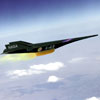
|
 |

Additional coverage for subscribers:
 VIDEO:
TUESDAY'S LAUNCH OF THE X-43A VEHICLE TO MACH 10 QT VIDEO:
TUESDAY'S LAUNCH OF THE X-43A VEHICLE TO MACH 10 QT
 VIDEO:
LAUNCH RESULTS PRESENTED IN POST-FLIGHT BRIEFING QT VIDEO:
LAUNCH RESULTS PRESENTED IN POST-FLIGHT BRIEFING QT
 VIDEO:
FOOTAGE OF PRE-LAUNCH ACTIVITIES QT VIDEO:
FOOTAGE OF PRE-LAUNCH ACTIVITIES QT
 VIDEO:
THE B-52 TAKES OFF FROM EDWARDS TUESDAY QT VIDEO:
THE B-52 TAKES OFF FROM EDWARDS TUESDAY QT
 VIDEO:
PRE-FLIGHT NEWS CONFERENCE FOR THIS LAUNCH QT VIDEO:
PRE-FLIGHT NEWS CONFERENCE FOR THIS LAUNCH QT

PREVIOUS X-43A LAUNCHES:
 VIDEO:
CHASE PLANE VIDEO SHOWS JUNE 2001 MALFUNCTION QT VIDEO:
CHASE PLANE VIDEO SHOWS JUNE 2001 MALFUNCTION QT
 VIDEO:
SECOND X-43A IS SUCCESSFULLY LAUNCHED IN MARCH QT VIDEO:
SECOND X-43A IS SUCCESSFULLY LAUNCHED IN MARCH QT
 VIDEO:
EXTENDED CLIP OF SECOND LAUNCH AS SEEN LIVE QT VIDEO:
EXTENDED CLIP OF SECOND LAUNCH AS SEEN LIVE QT
 VIDEO:
SUCCESS DECLARED AT POST-LAUNCH PRESS BRIEFING QT VIDEO:
SUCCESS DECLARED AT POST-LAUNCH PRESS BRIEFING QT
 VIDEO:
PREVIEW ANIMATION SHOWING X-43A LAUNCH QT VIDEO:
PREVIEW ANIMATION SHOWING X-43A LAUNCH QT
 SUBSCRIBE NOW SUBSCRIBE NOW

|
European probe arrives in orbit around the Moon
The European Space Agency's SMART-1 spacecraft is successfully making its first orbit of the Moon. Powered by an ion engine, this craft is demonstrating technologies for future planetary missions.
 FULL STORY FULL STORY
 |  |
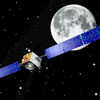
|
 |
|
Tuesday:
November 16, 2004 | |
0401 GMT |
 |
NASA scramjet launch postponed to today
NASA will try again today to launch its scramjet-powered X-43A hypersonic research craft to Mach 10 after Monday's attempt was foiled by glitches that kept the mission on the ground.
 MISSION STATUS CENTER MISSION STATUS CENTER
 |  |

|
 |

Additional coverage for subscribers:
 VIDEO:
PRE-FLIGHT NEWS CONFERENCE FOR THIS LAUNCH QT VIDEO:
PRE-FLIGHT NEWS CONFERENCE FOR THIS LAUNCH QT
 VIDEO:
CHASE PLANE VIDEO SHOWS JUNE 2001 MALFUNCTION QT VIDEO:
CHASE PLANE VIDEO SHOWS JUNE 2001 MALFUNCTION QT
 VIDEO:
SECOND X-43A IS SUCCESSFULLY LAUNCHED IN MARCH QT VIDEO:
SECOND X-43A IS SUCCESSFULLY LAUNCHED IN MARCH QT
 VIDEO:
EXTENDED CLIP OF SECOND LAUNCH AS SEEN LIVE QT VIDEO:
EXTENDED CLIP OF SECOND LAUNCH AS SEEN LIVE QT
 VIDEO:
SUCCESS DECLARED AT POST-LAUNCH PRESS BRIEFING QT VIDEO:
SUCCESS DECLARED AT POST-LAUNCH PRESS BRIEFING QT
 VIDEO:
PREVIEW ANIMATION SHOWING X-43A LAUNCH QT VIDEO:
PREVIEW ANIMATION SHOWING X-43A LAUNCH QT
 SUBSCRIBE NOW SUBSCRIBE NOW

|
James Webb mirror building moves ahead
NASA's James Webb Space Telescope (JWST) moved a major step forward with the opening of a state-of-the-art facility in Alabama that will machine the observatory's optical components.
Northrop Grumman Corporation is the prime contractor for JWST, leading the observatory's design and development team under contract to NASA's Goddard Space Flight Center.
 FULL STORY FULL STORY
 |  |
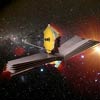
|
 |
NASA helps create complete human genome activity
Results of NASA scientists' recent research on human DNA are enhancing our knowledge about human genetics and may help us to better understand human diseases.
 FULL STORY FULL STORY
 |  |

|
 |
|
Monday:
November 15, 2004 | |
0302 GMT |
 |
Delta rocket to launch NASA observatory Wednesday
An agile gamma-ray observatory with a focus on the most intense explosions in the cosmos -- cataclysmic blasts occurring every day throughout the universe that seemingly foreshadow the creation of black holes -- will be launched into space Wednesday from Cape Canaveral, Florida.
 MISSION STATUS CENTER - live updates! MISSION STATUS CENTER - live updates!
 LAUNCH EVENTS TIMELINE LAUNCH EVENTS TIMELINE
 GROUND TRACK MAP GROUND TRACK MAP
 |  |

|
 |
NASA 'scramjet' to launch on Mach 10 flight Monday
NASA's high-risk, high-payoff Hyper-X Program is ready to attempt its greatest challenge yet -- flying a "scramjet"-powered X-43A research vehicle at nearly 10 times the speed of sound. Launch will take place in restricted U.S. Naval airspace over the Pacific Ocean northwest of Los Angeles on Monday around 2200 GMT (5 p.m. EST).
 FULL STORY FULL STORY
 |  |

|
 |

Additional coverage for subscribers:
 VIDEO:
X-43A PRE-FLIGHT NEWS CONFERENCE QT VIDEO:
X-43A PRE-FLIGHT NEWS CONFERENCE QT
 SUBSCRIBE NOW SUBSCRIBE NOW

|
|
Sunday:
November 14, 2004 | |
0241 GMT |
 |
Black hole found to
precede galaxy bulge
Astronomers using the Very Large Array radio telescope to study the most distant known quasar have found a tantalizing clue that may answer a longstanding cosmic chicken-and-egg question: which came first, supermassive black holes or giant galaxies?
 FULL STORY FULL STORY
 |  |

|
 |
|
Saturday:
November 13, 2004 | |
0429 GMT |
 |
Satellite proves El Nino holds reins on global rains
NASA scientists recently found El Nino is the main driver of the change in rain patterns all around the world. The joint U.S.-Japanese Tropical Rainfall Measuring Mission satellite has enabled scientists to look around the globe and determine where the year-to-year changes in rainfall are greatest.
 FULL STORY FULL STORY
 |  |
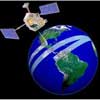
|
 |
OTHER HEADLINES Additional stories today
|
 |
Scientific paper submitted from space -- A scientific manuscript submitted by International Space Station astronauts while in space was published this past week. The research findings show minimally trained operators using remote guidance can perform ultrasound in space.

NASA's new supercomputer ranked among world's fastest -- NASA announced that its newest supercomputer, 'Columbia,' was named one of the world's most powerful production supercomputers by the TOP500 Project at SC2004, the International Conference of High Performance Computing, Networking, and Storage in Pittsburgh.
|
 |
|
Friday:
November 12, 2004 | |
0411 GMT |
 |
Martian moon Phobos in color for close-up look
The European Space Agency's Mars Express spacecraft has taken high-resolution pictures of the Martian moon Phobos. The pictures show new detail that will keep planetary scientists busy for years, working to unravel the mysteries of this moon.
 FULL STORY FULL STORY
 |  |
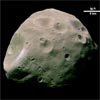
|
 |
Astronomers make a star
The Hale Telescope on Palomar Mountain has been gathering light from the depths of the universe for 55 years. It finally sent some back early last week as a team of astronomers created an artificial star by propagating a 4-watt laser beam out from the Hale Telescope and up into the night sky.
 FULL STORY FULL STORY
 |  |
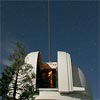
|
 |
|
Thursday:
November 11, 2004 | |
0222 GMT |
 |
Mars rover Opportunity looking for crater exit
Operators of NASA's Mars Exploration Rover Opportunity have determined that a proposed route eastward out of "Endurance Crater" is not passable, so the rover will backtrack to leave the crater by a southward route, perhaps by retracing its entry path.
 FULL STORY FULL STORY
 |  |
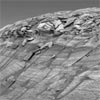
|
 |
Mysterious 'baby' planet
In June, researchers announced they had located a potential planet around another star so young that it defied theorists' explanations. Now a new team of planet-formation specialists are backing up the original conclusions, saying they've confirmed that the hole formed in the star's dusty disk could very well have been formed by a new planet.
 FULL STORY FULL STORY
 |  |
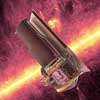
|
 |
Hubble tracks asteroid
While analyzing Hubble Space Telescope images of the Sagittarius dwarf irregular galaxy, an international team of astronomers were surprised to see the trail of a faint asteroid that had drifted across the field of view during the exposures. The trail is seen as a series of reddish arcs on the right in this Advanced Camera for Surveys image.
 FULL STORY FULL STORY
 |  |
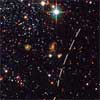
|
 |
|
Wednesday:
November 10, 2004 | |
0437 GMT |
 |
Spitzer discovery is good news for planet Pluto
Pluto's status as our solar system's ninth planet may be safe if a recently discovered Kuiper Belt Object is a typical "KBO" and not just an oddball. Astronomers have new evidence that KBOs are smaller than previously thought.
 FULL STORY FULL STORY
 |  |
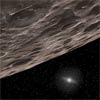
|
 |
Keck reveals Uranus ring, atmospheric fireworks
As summer draws to a close in the southern hemisphere of Uranus, storm clouds are brewing in the upper atmosphere, northern hemisphere winds are gusting to 250 miles per hour, and the planet's rings are getting brighter every day.
 FULL STORY FULL STORY
 |  |
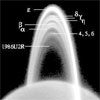
|
 |
Weird weather of Uranus
Capitalizing on the incomparable optical capabilities of the Keck Telescope, scientists have gained an unprecedented look at the atmosphere of Uranus, providing new insight into some of the most enigmatic weather in the solar system.
 FULL STORY FULL STORY
 |  |
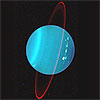
|
 |
|
Tuesday:
November 9, 2004 | |
0350 GMT |
 |
Objects, density waves seen in Saturn's rings
A University of Colorado at Boulder-built instrument riding on the Cassini-Huygens spacecraft is being used to resolve objects in Saturn's rings smaller than a football field, making them twice as sharp as any previous ring observations.
 FULL STORY FULL STORY
 |  |
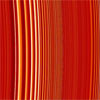
|
 |
Spitzer telescope looks into dark and dusty places
Two new results from NASA's Spitzer Space Telescope released Tuesday are helping astronomers better understand how stars form out of thick clouds of gas and dust, and how the molecules in those clouds ultimately become planets.
 FULL STORY FULL STORY
 |  |
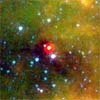
|
 |
OTHER HEADLINES Additional stories today
|
 |
Northrop Grumman, Boeing plan space exploration team -- Northrop Grumman Corporation and The Boeing Company have signed a memorandum of agreement that outlines the structure of a team that will compete for NASA's Crew Exploration Vehicle and other elements of Project Constellation, a planned architecture of human and robotic space systems that will allow astronauts to travel to and explore the moon, Mars and beyond. The two companies expect to finalize the teaming agreement in the near future.

Lockheed delivers structure for AEHF satellite -- Lockheed Martin announced that it has delivered on-schedule the flight structure and key payload support equipment to Northrop Grumman for assembly of the first space vehicle in the Advanced Extremely High Frequency (AEHF) program. AEHF satellites will provide global, highly secure, protected, survivable communications for warfighters in all services within the Department of Defense.
|
 |
|
Tuesday:
November 9, 2004 | |
0001 GMT |
 |
Cassini observations show dynamic dance at Saturn
A University of Colorado at Boulder professor involved with the Cassini-Huygens mission is reporting an ever-changing vista at the frontiers of Saturn, featuring wayward moons, colliding meteoroids, rippling rings and flickering auroras.
 FULL STORY FULL STORY
 |  |
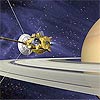
|
 |
Cassini radar sees flow-like feature across Titan
A strikingly bright, lobate feature has turned up in one of Cassini's first radar images of Saturn's moon Titan. It looks like something that "oozed across the surface," says a radar team member.
 FULL STORY FULL STORY
 |  |
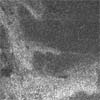
|
 |
Autopilot demonstrator launch put off yet again
Questions raised over the weekend about the structural loads NASA's DART rendezvous technology spacecraft would endure during its ascent aboard an Orbital Sciences Pegasus XL rocket has prompted a scrub of Tuesday's planned launch opportunity.
 MISSION STATUS CENTER MISSION STATUS CENTER
 |  |
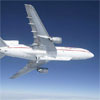
|
 |
Modernized version of Soyuz rocket launched
An updated version of Russia's venerable Soyuz rocket took its first flight Monday, carrying a dummy satellite during a successful qualification launch. The Soyuz 2 rocket lifted off from Plesetsk Cosmodrome in northern Russia at 1830 GMT after several delays in recent weeks.
 FULL STORY FULL STORY
 |  |
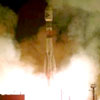
|
 |
|
Monday:
November 8, 2004 | |
0001 GMT |
 |
Origin of cosmic rays revealed with gamma rays
A team of UK astronomers working with international partners has produced the first ever image of an astronomical object using high energy gamma rays, helping to solve a 100 year old mystery - an origin of cosmic rays.
 FULL STORY FULL STORY
 |  |
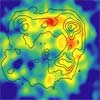
|
 |
|
Sunday:
November 7, 2004 | |
0351 GMT |
 |
Crunch, squelch or splash on Saturn's moon Titan?
The prospect of the Huygens probe landing on a hard, soft or liquid surface when it lands on Titan next January still remain following further analysis of data taken during the Cassini mother ship's closest encounter with Saturn's largest moon during its fly-by on October 26.
 FULL STORY FULL STORY
 |  |
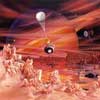
|
 |
Radar image shows Titan's surface live and in color
Saturn's moon Titan shows a sharp contrast between its smooth and rough edges in a new false-color radar image. Titan's surface lies beneath a thick coat of hazy clouds, but Cassini's radar instrument can peer through to show finer surface features.
 FULL STORY FULL STORY
 |  |
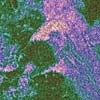
|
 |
|
Saturday:
November 6, 2004 | |
0831 GMT |
 |
Delta rocket puts on late-night show with GPS launch
After a nerve-racking stay on its Cape Canaveral launch pad with uncomfortably close encounters by two powerful hurricanes, a Boeing Delta 2 rocket finally thundered into space Saturday where it successfully deployed a Global Positioning System satellite to aid U.S. military forces around the world.
 FULL STORY FULL STORY
 MISSION STATUS CENTER MISSION STATUS CENTER
 PHOTO GALLERY: FRIDAY'S TOWER ROLLBACK PHOTO GALLERY: FRIDAY'S TOWER ROLLBACK
 PHOTO GALLERY: FIRST LAUNCH ATTEMPT PHOTO GALLERY: FIRST LAUNCH ATTEMPT
 |  |
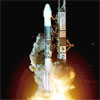
|
 |

Additional coverage for subscribers:
 VIDEO:
DELTA ROCKET LIFTS OFF WITH GPS 2R-13 QT VIDEO:
DELTA ROCKET LIFTS OFF WITH GPS 2R-13 QT
 VIDEO:
LONGER CLIP SHOWING THE NIGHTTIME ASCENT QT VIDEO:
LONGER CLIP SHOWING THE NIGHTTIME ASCENT QT
 VIDEO:
ALARM STOPS FRIDAY MORNING'S COUNTDOWN QT VIDEO:
ALARM STOPS FRIDAY MORNING'S COUNTDOWN QT
 SUBSCRIBE NOW SUBSCRIBE NOW

|
NASA grows ice for space shuttle testing
NASA is simulating conditions typical of space shuttle launch days to see what kinds of ice and frost form on the foam insulation of the super-cooled External Tank. Engineers are trying to understand better how much ice can safely accumulate on the tank without becoming a debris hazard.
 FULL STORY FULL STORY
 |  |
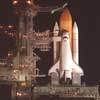
|
 |
NASA's prize competition solicits ideas and partners
To cast a wide net for supporting future prize competitions, NASA's Centennial Challenges program has issued two Requests for Information and one Announcement of Partnership Opportunity. Centennial Challenges seeks novel solutions to NASA's mission challenges from non-traditional sources of innovation in academia, industry and the public.
 FULL STORY FULL STORY
 |  |

|
 |
|
Friday:
November 5, 2004 | |
0720 GMT |
 |
Hurricane-delayed Delta 2 rocket postponed again
A glitch in the final minute of the countdown halted this morning's launch of Boeing's Delta 2 rocket carrying the next Global Positioning System satellite, delaying the mission 24 hours. Liftoff will be reattempted Friday night at 12:39 a.m. EST.
 MISSION STATUS CENTER - live updates! MISSION STATUS CENTER - live updates!
 PHOTO GALLERY: SERVICE TOWER ROLLBACK PHOTO GALLERY: SERVICE TOWER ROLLBACK
 LAUNCH EVENTS TIMELINE LAUNCH EVENTS TIMELINE
 GROUND TRACK MAP GROUND TRACK MAP
 |  |

|
 |
Spirit adds clues about history of rocks in hills
All the scientific tools on NASA's two Mars Exploration Rovers are still working well, a full 10 months after Spirit's dramatic landing. The ones on Spirit are adding fresh evidence about the history of layered bedrock in a hill the rover is climbing.
 FULL STORY FULL STORY
 |  |
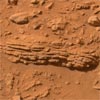
|
 |
Hubble spots rare triple eclipse on Jupiter
At first glance, Jupiter looks like it has a mild case of the measles. Five spots -- one colored white, one blue, and three black -- are scattered across the upper half of the planet. Closer inspection by NASA's Hubble Space Telescope reveals that these spots are actually a rare alignment of three of Jupiter's largest moons -- Io, Ganymede, and Callisto -- across the planet's face.
 FULL STORY FULL STORY
 |  |
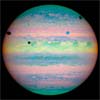
|
 |
|
Thursday:
November 4, 2004 | |
0243 GMT |
 |
Launch day for hurricane-delayed Delta rocket arrives
After glancing blows by powerful hurricanes and several technical snags, the launch countdown for Boeing's Delta 2 rocket carrying a replacement Global Positioning System satellite has finally reached the last hours to blastoff.
 MISSION STATUS CENTER MISSION STATUS CENTER
 |  |
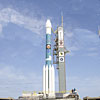
|
 |
NASA delays launch of autopilot experiment again
Scheduling conflicts on the Western Range at Vandenberg Air Force Base in California and the impacts from solar flare activity will prevent an attempt at launching NASA's Demonstration of Autonomous Rendezvous Technology spacecraft on Thursday.
 MISSION STATUS CENTER MISSION STATUS CENTER
 |  |
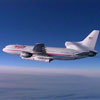
|
 |
OTHER HEADLINES Additional stories today
|
 |
Contract means sunny outlook for European weather forecasting -- The contract for a fourth Meteosat Second Generation (MSG) spacecraft was signed this week, ensuring continuity of European meteorological satellite services with the delivery of data for weather forecasting, climate and the environment for many years into the future.

Lockheed to build MUOS using cellular technology -- A Lockheed Martin-led team will employ third-generation commercial cellular technology to build the Mobile User Objective System (MUOS), an advanced narrowband tactical satellite communications system that will provide significantly improved and assured communications for U.S. warfighters, the company announced at MILCOM 2004 in Monterey.
|
 |
|
Wednesday:
November 3, 2004 | |
0359 GMT |
 |
International Space Station crews learn lessons
Each crew aboard the International Space Station discovers more and more about what it takes to live and work in space for long periods of time. This year, the fourth for humans continuously staffing the Station since the arrival of Expedition 1 on November 2, 2000, has proven to be an exceptional example.
 FULL STORY FULL STORY
 |  |

|
 |
|
Tuesday:
November 2, 2004 | |
0722 GMT |
 |
NASA & U.S. Navy celebrate spirit of exploration
NASA Administrator Sean O'Keefe acknowledged past acts of discovery and heroism, while challenging future generations to continue the American spirit of exploration during a ceremony Monday on board the historic museum frigate USS Constellation, docked at the U.S. Naval Academy in Annapolis, Md.
 FULL STORY FULL STORY
 |  |

|
 |
Laser technology tracks changes in Mount St. Helens
U.S. Geological Survey and NASA scientists studying Mount St. Helens are using high-tech Light Detection and Ranging technology to analyze changes in the surface elevation of the crater, which began deforming in late September 2004.
 FULL STORY FULL STORY
 |  |
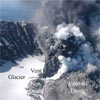
|
 |
Weather outlook favorable for Delta 2 launch
The weather forecast for Friday's early morning launch of the Boeing Delta 2 rocket carrying a Global Positioning System satellite is predicting generally favorable conditions.
 MISSION STATUS CENTER MISSION STATUS CENTER
 |  |
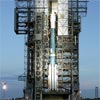
|
 |
OTHER HEADLINES Additional stories today
|
 |
Loral building Intelsat Americas-9 satellite -- Space Systems/Loral says it has reached agreement with Intelsat for the design of Intelsat Americas-9 (IA-9), a high-power, C- and Ku-band satellite that will provide service to North America, Central America and the Caribbean. SS/L has been authorized to proceed on the manufacture of IA-9 immediately.

Boeing completes SBSS pathfinder review -- Boeing announced Monday that in partnership with Northrop Grumman it has successfully completed the Integrated Baseline Review for the Space Based Space Surveillance (SBSS) system. This is a significant program milestone.
|
 |
|
Monday:
November 1, 2004 | |
0001 GMT |
 |
Delta 4-Heavy launch date depends on data review
The Boeing Company is beginning an exhaustive review of testing records and data that will determine when the inaugural Delta 4-Heavy rocket will be given clearance for blastoff from Cape Canaveral, Florida.
 FULL STORY FULL STORY
 DELTA 4-HEAVY ARCHIVE DELTA 4-HEAVY ARCHIVE
 |  |
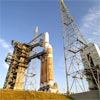
|
 |
Added complexity of Delta 4-Heavy put to the test
Throughout this year's on-pad testing sequence, officials have focused on three key challenges created by the Delta 4-Heavy and its trio of Common Booster Cores that generate the 1.9 million pounds of thrust to propel the 23-story rocket off the launch pad.
 FULL STORY FULL STORY
 |  |
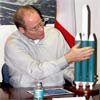
|
 |
Photo gallery: Delta 4-Heavy launch day rehearsal
The mobile service tower is rolled back to expose Boeing's Delta 4-Heavy rocket for the Wet Dress Rehearsal launch day simulation on October 26 at Cape Canaveral Air Force Station's pad 37B. This picture collection shows the massive rocket just after sunrise.
 ENTER PHOTO GALLERY ENTER PHOTO GALLERY
 |  |
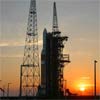
|
 |
|
Sunday:
October 31, 2004 | |
0001 GMT |
 |
NASA's Mars rovers pass the 50,000-picture mark
A view of the sundial-like calibration target on NASA's Mars Exploration Rover Spirit, with a bit of martian terrain in the background, is the 50,000th image from the twin rovers that have been exploring Mars since January.
 FULL STORY FULL STORY
 |  |
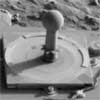
|
 |
|
Saturday:
October 30, 2004 | |
0035 GMT |
 |
Pit chains hint at recent marsquakes on red planet
Strings of depressions dotting the Martian landscape indicate that seismic activity - marsquakes - may still be reshaping the surface of the planet. These pit chains occur along dilational faults, partially filled or open cavities that served as conduits for past groundwater flow.
 FULL STORY FULL STORY
 |  |
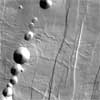
|
 |
NASA sets launch date for first post-Columbia shuttle
After an extensive review, NASA is planning its Return to Flight space shuttle mission, designated STS-114, for a launch window that opens in May 2005.
 FULL STORY FULL STORY
 EARLIER STORY EARLIER STORY
 |  |
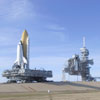
|
 |
|
Friday:
October 29, 2004 | |
0621 GMT |
 |
Cassini's radar shows Titan's young active surface
The first radar images of Saturn's moon Titan show a very complex geological surface that may be relatively young. Previously, Titan's surface was hidden behind a veil of thick haze.
 FULL STORY FULL STORY
 RADAR IMAGERY RADAR IMAGERY
 |  |
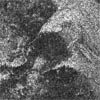
|
 |

Additional coverage for subscribers:
 VIDEO:
THURSDAY'S BRIEFING ON RADAR IMAGES OF TITAN SURFACE QT VIDEO:
THURSDAY'S BRIEFING ON RADAR IMAGES OF TITAN SURFACE QT
 SUBSCRIBE NOW SUBSCRIBE NOW

|
Two views of Titan's haze
Titan's planet-wide stratospheric haze is observed in Cassini's first close encounter with the shrouded moon. This image shows Titan's night-side backlit by the Sun after the space probe's closest approach to the moon. The haze layer ringing the planet is illuminated because the small particles scatter significant sunlight in the forward direction.
 FULL STORY FULL STORY
 |  |
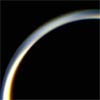
|
 |
Gigantic cosmic corkscrew reveals new details
Making an extra effort to image a faint, gigantic corkscrew traced by fast protons and electrons shot out from a mysterious microquasar paid off for a pair of astrophysicists who gained new insights into the beast's inner workings and also resolved a longstanding dispute over the object's distance.
 FULL STORY FULL STORY
 |  |
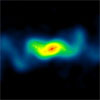
|
 |
OTHER HEADLINES Additional stories today
|
 |
NASA wins financial award -- NASA has been named the 2004 Agency of the Year by a federal organization honoring excellence in financial management. NASA was honored for its implementation of the Web Time and Attendance Distribution System (WebTADS), a Web-based system that collects employee time and attendance information.
|
 |
|
Thursday:
October 28, 2004 | |
0515 GMT |
 |
Scientists elated by Cassini's Titan observations
After years of anticipation, the Cassini spacecraft beamed back smog-piercing close-up images of Saturn's moon Titan late Tuesday, revealing a strange, striated landscape that both thrilled - and mystified - planetary scientists.
 FULL STORY FULL STORY
 |  |

|
 |

Additional coverage for subscribers:
 VIDEO:
WEDNESDAY'S POST-FLYBY SCIENCE NEWS CONFERENCE QT VIDEO:
WEDNESDAY'S POST-FLYBY SCIENCE NEWS CONFERENCE QT
 SUBSCRIBE NOW SUBSCRIBE NOW

|
Launch of NASA autopilot experiment scrubbed again
While closing up the Pegasus rocket's nose cone for Thursday's planned launch of NASA's DART rendezvous technology demonstrator, workers discovered contamination inside the shroud that must be cleaned before the mission can proceed.
 MISSION STATUS CENTER MISSION STATUS CENTER
 |  |
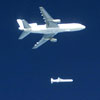
|
 |

Additional coverage for subscribers:
 VIDEO:
NARRATED FOOTAGE OF LAUNCH CAMPAIGN QT VIDEO:
NARRATED FOOTAGE OF LAUNCH CAMPAIGN QT
 VIDEO:
MONDAY'S PRE-LAUNCH PRESS CONFERENCE QT VIDEO:
MONDAY'S PRE-LAUNCH PRESS CONFERENCE QT
 VIDEO:
DETAILED OVERVIEW OF THE DART MISSION QT VIDEO:
DETAILED OVERVIEW OF THE DART MISSION QT
 SUBSCRIBE NOW SUBSCRIBE NOW

|
Workers changing batteries on next Delta 2 rocket
Launch of Boeing's Delta 2 rocket carrying a replacement satellite for the U.S. military's Global Positioning System has been re-targeted for late next week after technicians exchange batteries on the third stage, the Air Force said Wednesday.
 FULL STORY FULL STORY
 MISSION STATUS CENTER MISSION STATUS CENTER
 EARLIER STORY EARLIER STORY
 |  |

|
 |
Stellar survivor from 1572 A.D. supports theory
An international team of astronomers is announcing today that they have identified the probable surviving companion star to a titanic supernova explosion witnessed in the year 1572 by the great Danish astronomer Tycho Brahe and other astronomers of that era.
 FULL STORY FULL STORY
 |  |

|
 |
|
Wednesday:
October 27, 2004 | |
0801 GMT |
 |
Cassini has close encounter with Saturn's moon Titan
NASA's Cassini spacecraft streaked by Saturn's smoggy moon Titan Tuesday, targeted to pass within just 750 miles of the planet-sized satellite to give scientists their first detailed glimpse of a world that, until now, has been shrouded in mystery. A news conference to discuss the pictures and data is planned for 1600 GMT (12 noon EDT) Wednesday.
 FULL STORY FULL STORY
 FLYBY TIMELINE FLYBY TIMELINE
 OUR CASSINI MISSION ARCHIVE OUR CASSINI MISSION ARCHIVE
 |  |

|
 |

Additional coverage for subscribers:
 VIDEO:
FLYBY EXPLAINED IN DETAILED ANIMATION WITH NARRATION QT VIDEO:
FLYBY EXPLAINED IN DETAILED ANIMATION WITH NARRATION QT
 VIDEO:
WHAT'S KNOWN ABOUT TITAN BEFORE THE FLYBY QT VIDEO:
WHAT'S KNOWN ABOUT TITAN BEFORE THE FLYBY QT
 VIDEO:
NARRATED MOVIE OF CLOUDS MOVING NEAR SOUTH POLE QT VIDEO:
NARRATED MOVIE OF CLOUDS MOVING NEAR SOUTH POLE QT
 VIDEO:
HOW CASSINI IMAGES ARE PROCESSED IS EXPLAINED QT VIDEO:
HOW CASSINI IMAGES ARE PROCESSED IS EXPLAINED QT
 SUBSCRIBE NOW SUBSCRIBE NOW

|
Titan up close
These raw, un-processed images of Saturn's moon Titan were taken by the Cassini spacecraft and transmitted to Earth on October 26. The pictures provide the closest views ever snapped of the hazy moon.
 PICTURE COLLECTION PICTURE COLLECTION
 |  |

|
 |

Additional coverage for subscribers:
 VIDEO:
FIRST PICTURES FROM FLYBY ARE RECEIVED AT JPL QT VIDEO:
FIRST PICTURES FROM FLYBY ARE RECEIVED AT JPL QT
 VIDEO:
29-MINUTE MOVIE OF PICTURES SHOWING TITAN SURFACE QT VIDEO:
29-MINUTE MOVIE OF PICTURES SHOWING TITAN SURFACE QT
 SUBSCRIBE NOW SUBSCRIBE NOW

|
|
Tuesday:
October 26, 2004 | |
0312 GMT |
 |
Cassini scientists ready for first close Titan flyby
The Cassini spacecraft is heading for its first close encounter with Saturn's moon Titan. University of Arizona scientists on the mission say Cassini will get its first real glimpse of Titan surface geology and digest its first gulp of rich Titan air. The first pictures from the close flyby are expected late tonight.
 FULL STORY FULL STORY
 TITAN FLYBY OVERVIEW TITAN FLYBY OVERVIEW
 |  |

|
 |
Eyes on Xanadu
This stunning image taken Sunday reveals Titan's bright "continent-sized" terrain known as Xanadu. It was acquired with the narrow angle camera on Cassini as the craft sped toward its first close encounter with the moon of Saturn.
 FULL STORY FULL STORY
 |  |

|
 |
Lonely halo raises questions about dark matter
Dark matter continues to confound astronomers, as NASA's Chandra X-ray Observatory demonstrated with the detection of an extensive envelope of dark matter around an isolated elliptical galaxy. This discovery conflicts with optical data that suggest a dearth of dark matter around similar galaxies, and raises questions about how galaxies acquire and keep such dark matter halos.
 FULL STORY FULL STORY
 |  |

|
 |
|
Monday:
October 25, 2004 | |
0420 GMT |
 |
Survey finds mysterious new Milky Way companion
Most of the stars in our Milky Way galaxy lie in a very flat, pinwheel-shaped disk. Although this disk is prominent in images of galaxies similar to the Milky Way, there is also a very diffuse spherical "halo" of stars surrounding and enclosing the disks of such galaxies.
 FULL STORY FULL STORY
 |  |

|
 |
As the world turns, it drags space and time
An international team of NASA and university researchers has found the first direct evidence the Earth is dragging space and time around itself as it rotates.
 FULL STORY FULL STORY
 |  |

|
 |



